KubeSphere and VMware Cloud Native Solution
Executive Summary
Business Case
Running container workloads on VMware vSphere® requires a solution that is cost-effective, highly scalable, and easy to manage. Although Kubernetes delivers a decent solution for container orchestration, its steep learning curve and CLI-based working mode put a huge burden on operation and maintenance (O&M) personnel. On top of Kubernetes, KubeSphere is a container platform that can work together with VMware Cloud Native Storage (CNS) and VMware Antrea to build a one-stop modern application solution.
KubeSphere is an application-oriented multi-tenant container platform, which provides full-stack automated O&M capabilities and simplifies the DevOps workflows for enterprises. KubeSphere can run on Linux VMs powered by VMware vSphere or VMware Tanzu Kubernetes Grid and visualize the management of Kubernetes resources. This solution enables features such as multi-cluster management, logging, monitoring, alerting, notifications, audits, events, and metering and billing. Moreover, KubeSphere provides platform-level capabilities, such as App Store, DevOps, edge computing, and microservices governance.
KubeSphere can work together with VMware CNS and Antrea to achieve infrastructure automation and platform extensibility, which simplifies and automates Day 0 to Day 2 operations with Kubernetes. This solution provides a complete, automated, and one-stop platform for developers and O&M personnel to modernize and manage applications during the whole lifecycle. KubeSphere also helps IT personnel to reduce the learning curve and O&M costs, improves operation efficiency, and fuels digital transformation.
In this solution, we provide infrastructure administrators, developers, and maintenance personnel with the design, deployment, and best practices of KubeSphere on VMware vSphere with VMware vSAN™, to help enterprises run and manage modern applications.
Business Values
Deploying KubeSphere on VMware vSphere with vSAN features the following benefits:
- Quick deployment. You can deploy KubeSphere on native Kuberenetes powered by VMware vSphere and vSAN at ease. vSphere Container Storage Interface (CSI) and Antrea are preinstalled in the KubeSphere App Store, so you can configure storage and networking in a few clicks.
- Independent O&M for IaaS and PaaS. For infrastructure administrators, you only need to operate and maintain Fibre Channel Storage Area Network (FC SAN) or Network Attached Storage (NAS) on vSphere or vSAN. For platform administrators, KubeSphere allows you to focus on how to manage container workloads and DevOps workflows.
- Cluster lifecycle management. KubeSphere simplifies the lifecycle management of Kubernetes clusters on vSphere with vSAN, and provides features such as cluster upgrade, certificate renewal, automatic backup, and parameter management.
- Storage and network security. You can use CNS for VMware vSphere to integrate storage of different types, including DAS, SAN, and NAS, and use a CSI for persistent storage on KubeSphere. Antrea powers KubeSphere to enable multi-layer network policies and traffic observability.
- Out-of-the-box PaaS. KubeSphere on VMware vSphere with vSAN is native to Kubernetes and provides out-of-the-box features, such as DevOps powered by Jenkins or Argo CD, microservices governance powered by Istio or Spring Cloud, containerized database management, and edge computing.
- Observability. KubeSphere provides various features for observability, such as unified logging, monitoring, and alerting, diverse notification channels, events, audits, and billing and metering.
- Multi-cluster or multi-cloud delivery. KubeSphere tailors delivery to meet business needs in active-active or geo-redundancy scenarios. To manage multiple clusters across clouds, KubeSphere supports cluster federation and enables observability for unified O&M.
Key Results
Powered by VMware vSphere and vSAN, KubeSphere achieves the following key results:
- Simplify resource management from the following aspects: Kubernetes-native O&M on VMware vSphere with vSAN, collaboration in open source ecosystems, integration with DevOps tools, and service governance.
- Increase sales for VMware and QingCloud and work together with VMware vSphere, vSAN, and NSX to provide a one-stop cloud native solution for existing enterprise users.
Audience
This solution is suitable for IT administrators, developers, O&M personnel, and engineers and experts engaged in planning, design, and deployment of VMware vSphere, vSAN, Kubernetes, and DevOps workloads. Before you read the following content, make sure you have some knowledge of VMware vSphere, vSAN, Kubernetes, and Docker.
Technology Overview
The following components work collaboratively to implement this solution:
- vSphere
- vSAN
- VMware CNS
- Antrea
- KubeSphere
VMware vSphere
VMware vSphere is a virtualization platform powered by VMware, which can transform a data center into a converged computing infrastructure that provides CPU, storage, and networking resources. VMware vSphere manages the infrastructure as a unified environment and provides you with the tools to manage the data center.
VMware vSAN
VMware vSAN uses a software-defined approach to creating shared storage for virtual machines (VMs). This service can virtualize local physical storage resources provided by ESXi servers and turn them into storage pools in which resources can be provisioned to VMs and applications on demand. vSAN is implemented in the ESXi hypervisor, and vSAN can be configured to work as a hybrid cluster or an all-flash cluster.
VMware CNS
VMware CNS for vSphere integrates with Kubernetes and allows Kubernetes to configure storage on demand on vSphere in a fully automated and scalable manner. This service also enables volume observability for administrators through vCenter.
VMware CNS allows administrators to run, monitor, and manage container and VM storage on the same platform. This simplifies container infrastructure storage, lifecycle management, and operations for administrators. VM and container storage provisioning on a unified platform reduces administrator learning costs and enables consistent operations across workloads and clouds. CNS can help you reduce time in managing infrastructure and focus more on building applications that deliver business value.
Antrea
Antrea is a Kubernetes-native network solution that uses Open vSwitch as the data plane at Layer 3 or 4 to provide network and security services for Kubernetes. Antrea can work as a Container Network Interface (CNI) plug-in to enable various network and security features, such as the configuration of static IP addresses, IP Address Management (IPAM), multi-cluster networking, overlay and underlay network construction, traffic encryption, layered and multi-dimensional network policies, network flow analysis and aggregation, egress gateways, LoadBalancer, and Traceflow.
KubeSphere
Built on top of Kubernetes, KubeSphere is a distributed operating system for cloud native applications. KubeSphere provides multiple features to build an enterprise-grade Kubernetes environment, such as multi-cloud and multi-cluster management, resource management, DevOps, application lifecycle management, microservices governance or service meshes, log query and collection, services and networks, multi-tenant management, monitoring and alerting, event and audit query, storage management, access control, GPU support, network policies, image registry management, and security management. KubeSphere abstracts away complex technical details of the underlying infrastructure, and helps enterprises seamlessly deploy, update, migrate, and manage existing containerized applications on various types of infrastructure. This way, KubeSphere allows developers to focus on application development, and O&M personnel can leverage enterprise-grade features to speed up DevOps workflows and delivery processes. The features include observability, troubleshooting, unified monitoring and log query, storage and network management, and easy-to-use CI/CD pipelines.
Solution Configuration
This section describes how to implement the solution from the following aspects:
- Architecture
- Hardware resources
- Software resources
- Network configuration
Architecture Diagram
Hardware Resources
Table 1. Hardware resources for KubeSphere on Linux
| PROPERTY | SPECIFICATION |
|
OS | Ubuntu 16.04/18.04/20.04 Debian Buster, Stretch CentOS 7.x Red Hat Enterprise Linux 7 SUSE Linux Enterprise Server 15 /openSUSE Leap 15.2 |
| CPU | > 2 vCPUs |
| RAM | > 4 GB |
| CRI | Docker, Containerd, CRI-O |
| Dependency | Socat, Conntrack |
| Disks | > 40 GB |
Software Resources
Table 2. Software resources for KubeSphere on Kubernetes
| Software | Version |
| Kubernetes | v1.19.x, v1.20.x, v1.21.x, v1.22.x, v1.23.x, and v1.24.x |
| StorageClass | Exist |
Network Configuration
Table 3. Ports used by KubeSphere
| Service | Protocol | action | SourcePort | DestPort |
| SSH | TCP | ALLOW | 22 |
|
| ETCD | TCP | ALLOW | 2379 |
2380 |
| APISERVER | TCP | ALLOW | 6443 |
|
| NODEPORT | TCP | ALLOW | 30000 |
32767 |
| MASTER | TCP | ALLOW | 10250 |
10258 |
| DNS | TCP | ALLOW | 53 |
|
| DNS | UDP | ALLOW | 53 |
|
| LOCAL-REGISTRY | TCP | ALLOW | 5000 |
|
| LOCAL-APT | TCP | ALLOW | 5080 |
|
| RPCBIND | TCP | ALLOW | 111 |
|
| METRICS-SERVER | TCP | ALLOW | 8443 |
|
Solution Validation
Test Overview
This section validates the feasibility of integrating KubeSphere with vSphere CSI and Antrea.
Integrate KubeSphere with vSphere CSI
This section guides you through how to install native Kubernetes and Kubesphere on VMs powered by VMware vSphere. In this example, VMware CNS is used for persistent storage, and KubeSphere helps you create workloads backed by the vSphere CSI driver. For example, you can create a stateful MySQL application with a persistent volume claim (PVC), test volume attaching, create volume snapshots, and delete or recover volumes.
Create a Kubernetes Cluster
To create a Kubernetes cluster at ease, we recommend that you use the open source tool KubeKey. KubeKey is an open source tool powered by QingCloud. This tool can help you create KubeSphere clusters and install KubeSphere at ease. You can use this tool to add cluster nodes, install Harbor registries, deploy cluster networks, storage plug-ins, and etcd clusters, renew cluster certificates, and quickly upgrade clusters.
To obtain KubeKey, run the following command:
curl -sfL https://get-kk.kubesphere.io | VERSION=v3.0.2 sh -
Docker allows you to run a MySQL application with one command, and KubeKey allows you to run a Kubernetes cluster and KubeSphere with one command. Run the following command to install Kubernetes and KubeSphere:
kk create cluster --with-kubernetes v1.23.8 --with-kubesphere v3.3.1
If you create a cluster with multiple nodes, run kk create config to create a configuration file. After you configure node information, run kk create cluster -f config.yaml to apply the file.
Sample code:
hosts:
- {name: master, address: 192.168.0.2, internalAddress: 192.168.0.2, user: ubuntu, password: Testing123}
- {name: node1, address: 192.168.0.3, internalAddress: 192.168.0.3, user: ubuntu, password: Testing123}
roleGroups:
etcd:
- master
control-plane:
- master
worker:
- node1
Wait until Kubernetes and KubeSphere are installed. This process might take about 20 minutes.
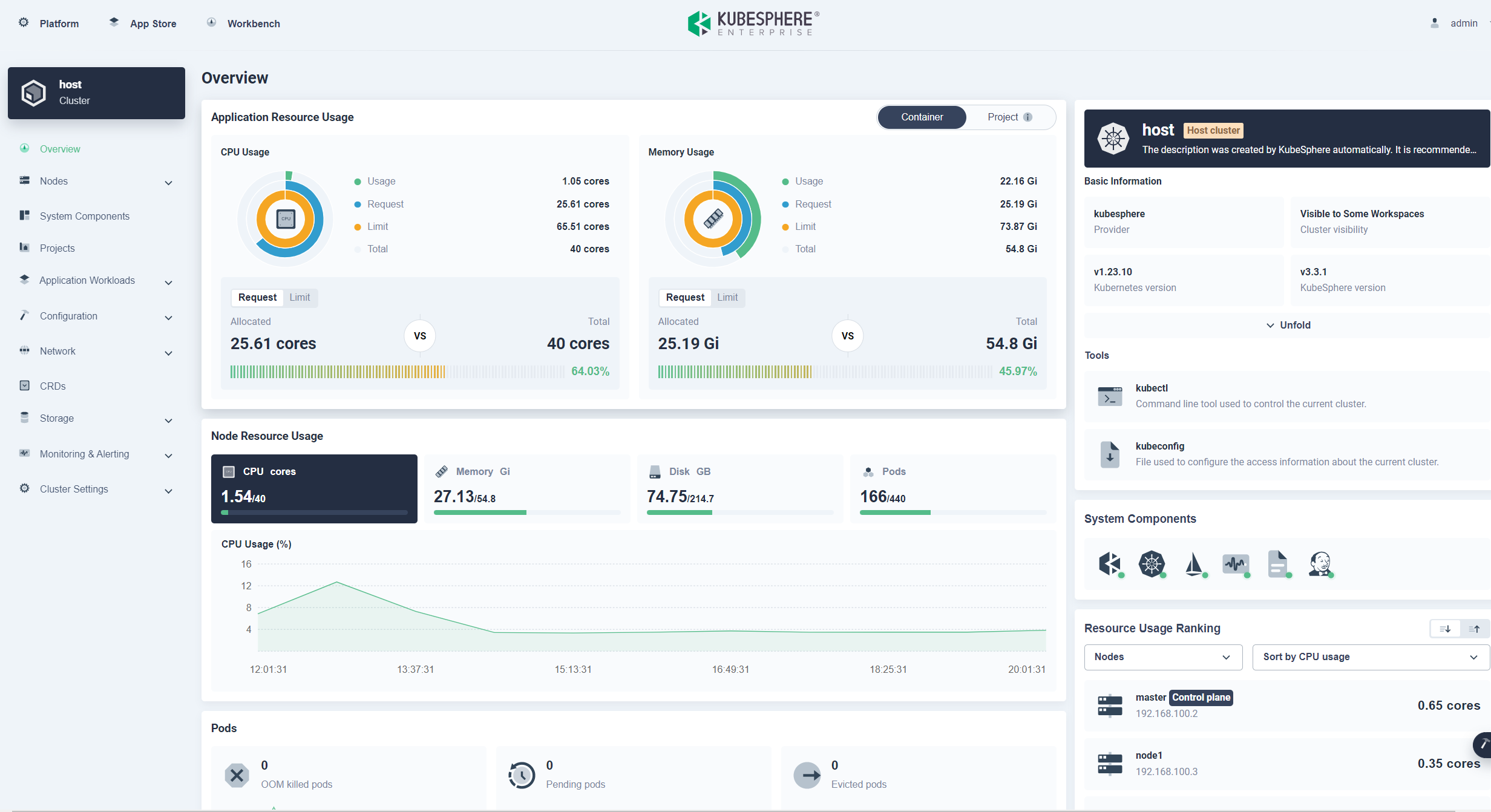
Install the storage plug-in for vSphere
vSphere CNS consists of the vCenter control plane and the storage plug-in for Kubernetes. The control plane is available for vCenter 6.7U3 and later, so you need only to install the CSI plug-in in the Kubernetes cluster backed by VMware vSphere.
Before you create a VM for Kubernetes, make sure the following conditions are met:
- VMware Tools is installed.
- disk.EnableUUID is set to true.
- The hardware version is 15 or later.
- A VMware Paravirtual SCSI controller is used for the VM.
Before you install the vSphere CSI driver, check its compatibility with vCenter and Kubernetes on the official website.
Install vsphere-cloud-controller-manager
Add labels to all nodes:
kubectl taint node k8s node.cloudprovider.kubernetes.io/uninitialized=true:NoSchedule
Download vsphere-cloud-controller-manager.yaml:
Modify the vCenter-related configuration in Secret and ConfigMap:
apiVersion: v1
kind: Secret
metadata:
name: vsphere-cloud-secret
namespace: kube-system
stringData:
10.0.0.1.username: "<ENTER_YOUR_VCENTER_USERNAME>"
10.0.0.1.password: "<ENTER_YOUR_VCENTER_PASSWORD>"
apiVersion: v1
kind: ConfigMap
metadata:
name: vsphere-cloud-config
namespace: kube-system
data:
vcenter:
<your-vcenter-name-here>:
server: 10.0.0.1
user: <use-your-vcenter-user-here>
password: <use-your-vcenter-password-here>
datacenters:
- Datacenter01
Run the following command to apply the file:
🐳 → kubectl apply -f vsphere-con-ma.yaml
serviceaccount/cloud-controller-manager created
secret/vsphere-cloud-secret created
configmap/vsphere-cloud-config created
rolebinding.rbac.authorization.k8s.io/servicecatalog.k8s.io:apiserver-authentication-reader created
clusterrolebinding.rbac.authorization.k8s.io/system:cloud-controller-manager created
clusterrole.rbac.authorization.k8s.io/system:cloud-controller-manager created
daemonset.apps/vsphere-cloud-controller-manager created
🐳 → kubectl get pods -A | grep vsphere
kube-system vsphere-cloud-controller-manager-km68c 1/1 Running 0 3m4s
Create a namespace named vmware-system-csi:
🐳 → kubectl create ns vmware-system-csi
namespace/vmware-system-csi created
Create a configuration file for the CSI driver:
cat /etc/kubernetes/csi-vsphere.conf
[Global]
cluster-id = "<cluster-id>"#Enter the cluster name
[VirtualCenter "<IP or FQDN>"] #Enter the IP address or FQDN of vCenter
insecure-flag = "<true or false>"#Specify the CA file and fingerprint if you set the value to false.
user = "<username>"
password = "<password>"
port = "<port>"
datacenters = "<datacenter1-path>"#Enter the path of the data center where the cluster nodes reside.
Generate a secret:
🐳 → kubectl create secret generic vsphere-config-secret --from-file=csi-vsphere.conf --namespace=vmware-system-csi
Install vsphere-csi-driver:
🐳 → kubectl apply -f https://raw.githubusercontent.com/kubernetes-sigs/vsphere-csi-driver/v2.6.0/manifests/vanilla/vsphere-csi-driver.yaml
Wait until all pods are running properly:
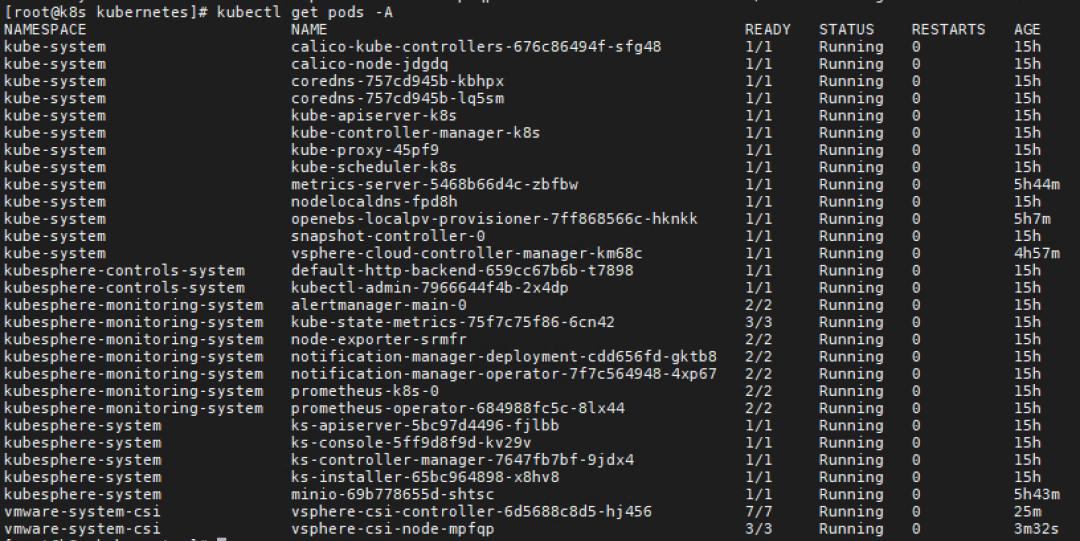
Query the status of csidriver and csinode:
🐳 → kubectl get csidriver
NAME ATTACHREQUIRED PODINFOONMOUNT STORAGECAPACITY TOKENREQUESTS REQUIRESREPUBLISH MODES AGE
csi.vsphere.vmware.com true false false <unset> false Persistent 85m
🐳 → kubectl get CSINODE
NAME DRIVERS AGE
k8s 1 16h
The vSphere CSI driver is installed. Then, configure the underlying storage and StorageClass.
Create a StorageClass
CNS makes Kubernetes aware of how to dynamically provision PVs based on storage policies or StorageClasses.
Create a StorageClass:
kind: StorageClass
apiVersion: storage.k8s.io/v1
metadata:
name: example-block-sc
annotations:
storageclass.kubernetes.io/is-default-class: "true"
provisioner: csi.vsphere.vmware.com
parameters:
storagepolicyname: "vSAN Default Storage Policy" #The storage policy.
# datastoreurl: "ds:///vmfs/volumes/vsan:52cdfa80721ff516-ea1e993113acfc77/" #The data storage, for example, NFS mounted to ESXi, FC/IP SAN, or local storage.
# csi.storage.k8s.io/fstype: "ext4" #The formatted file type.
In the KubeSphere web console, check the storage class and snapshot class.


Run a Stateful Application
In the App Store of KubeSphere, deploy a MySQL application to check whether PVs work for vSphere.
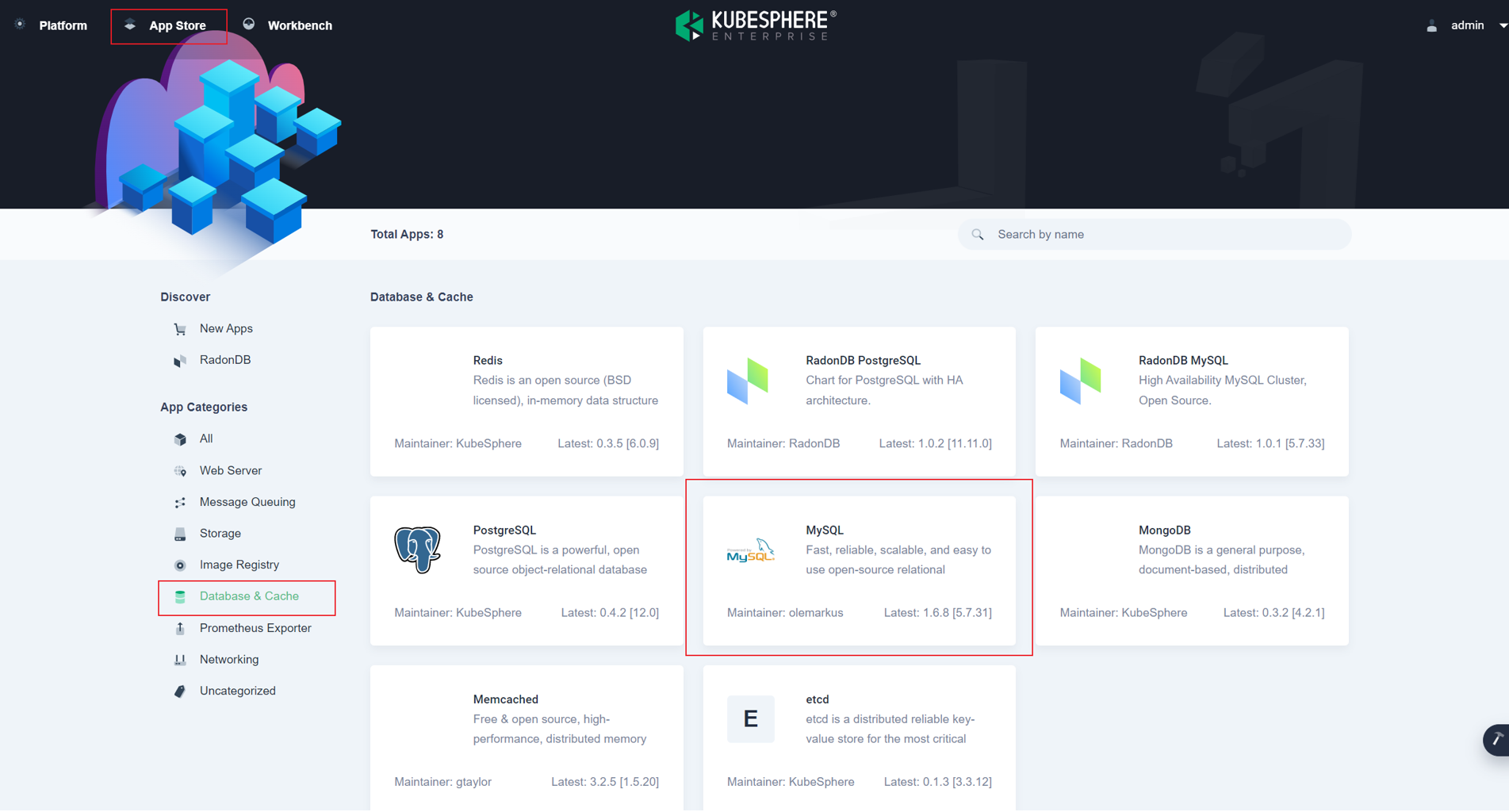
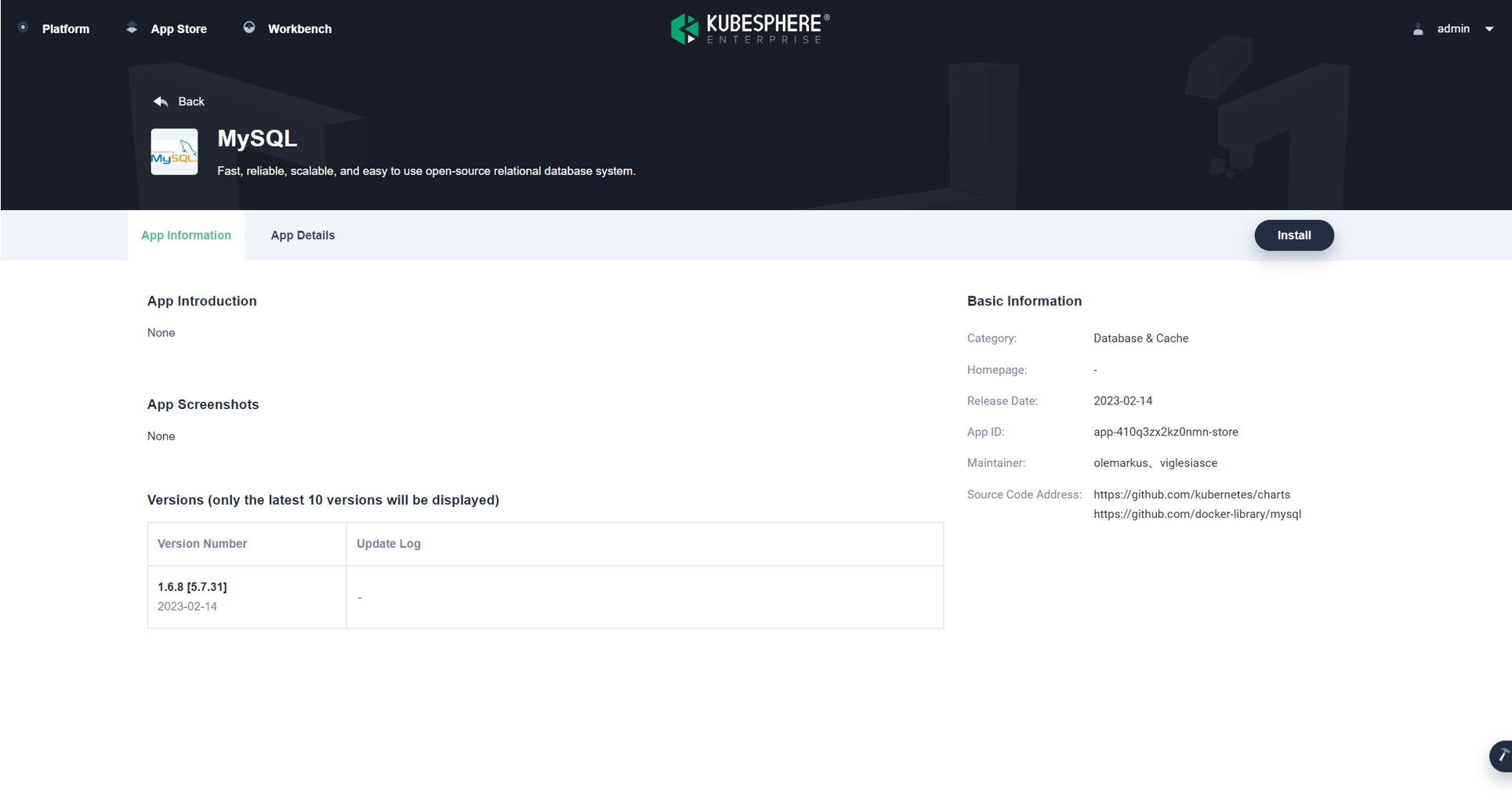
Set storageClass to example-block-sc, which was created based on the vSphere CSI driver:
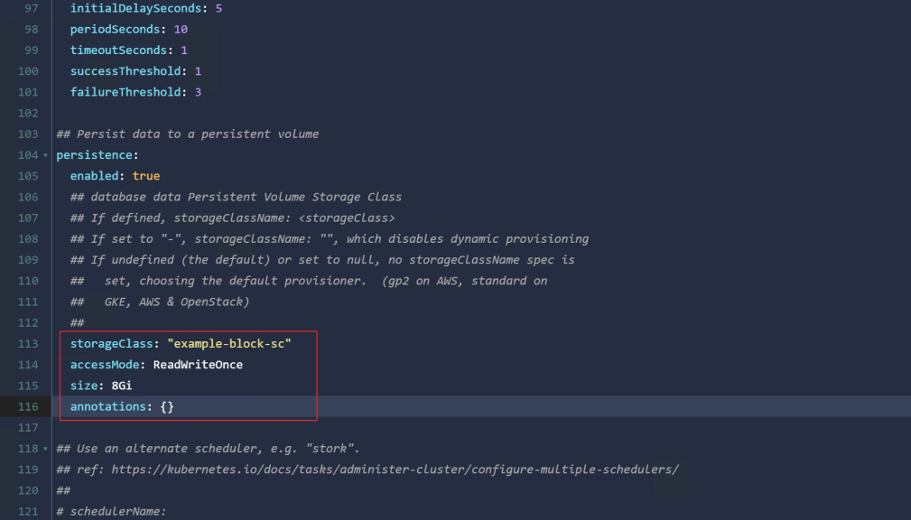
The following figure shows that the application with a PVC is created.
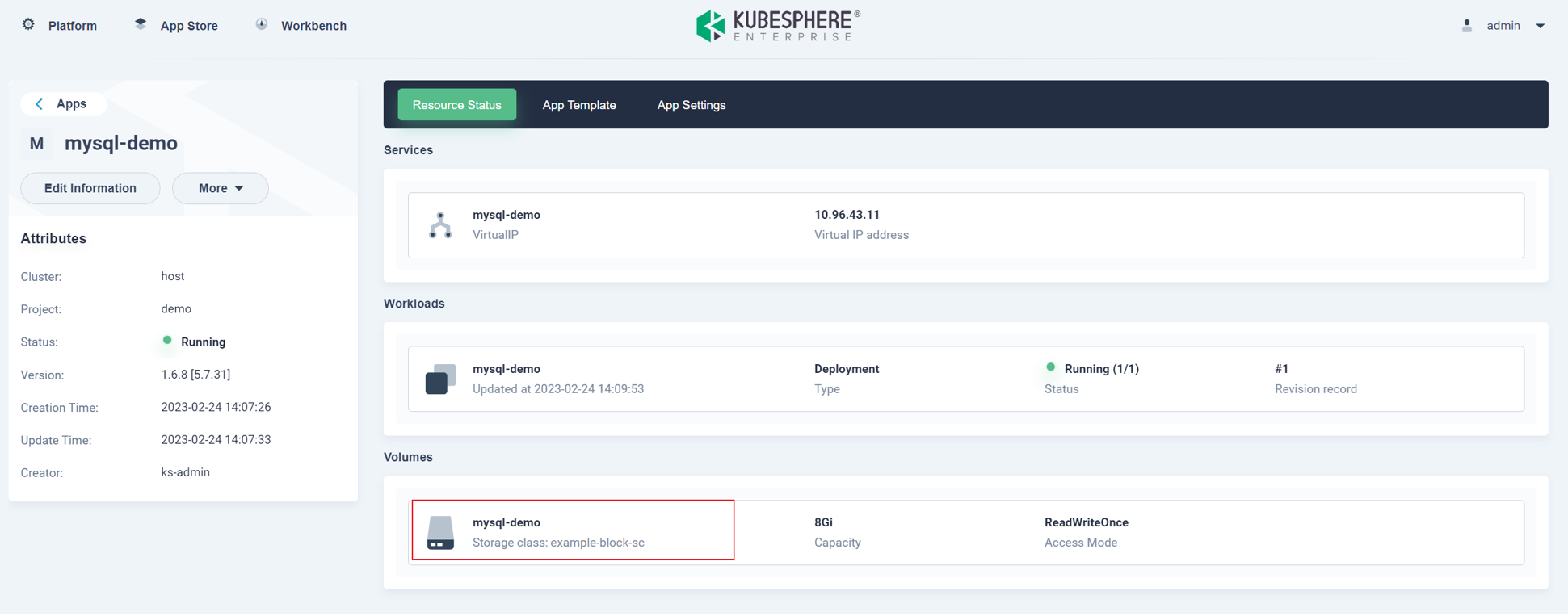
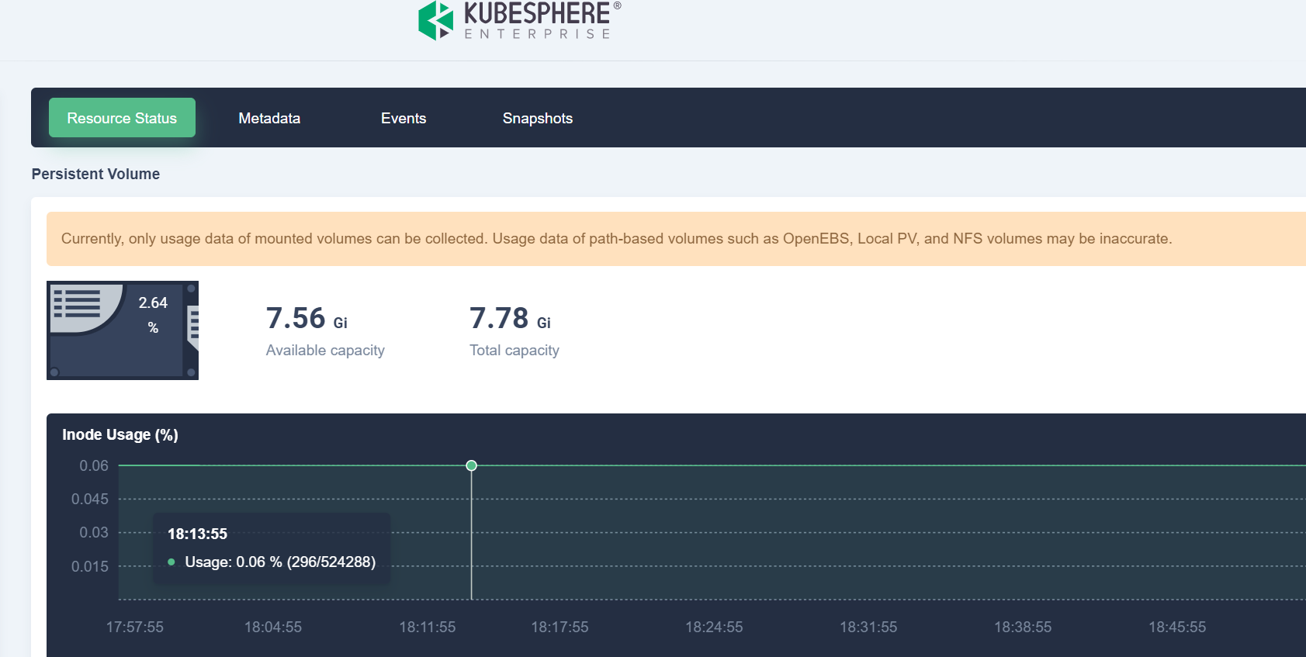
Go to vCenter, and you can view that an 8GB disk has been mounted to the VM. The capacity is the same as that defined in the PVC, and the backend storage is the same as that defined in the StorageClass.
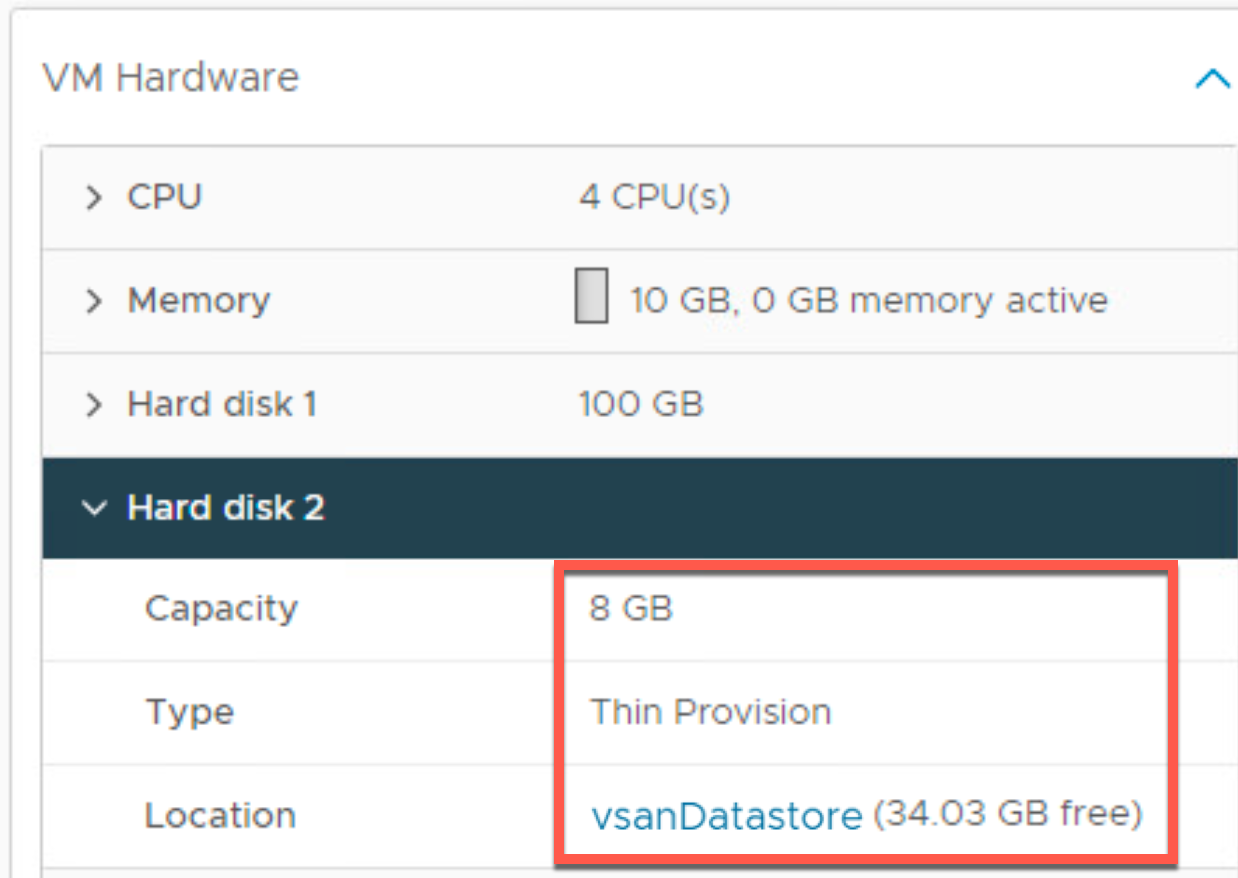
Open Terminal to connect to the MySQL database:
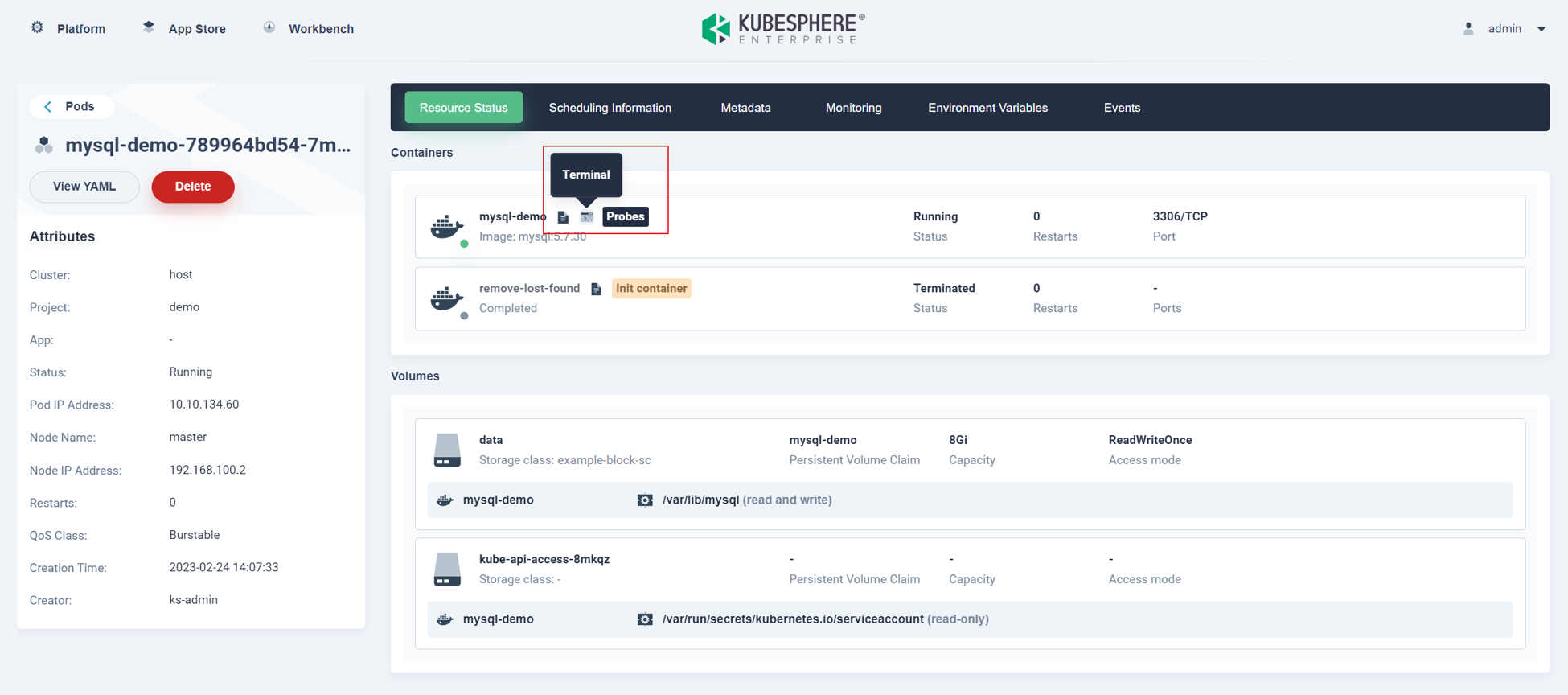
Create a table and insert example values:

Create a snapshot for the PVC:
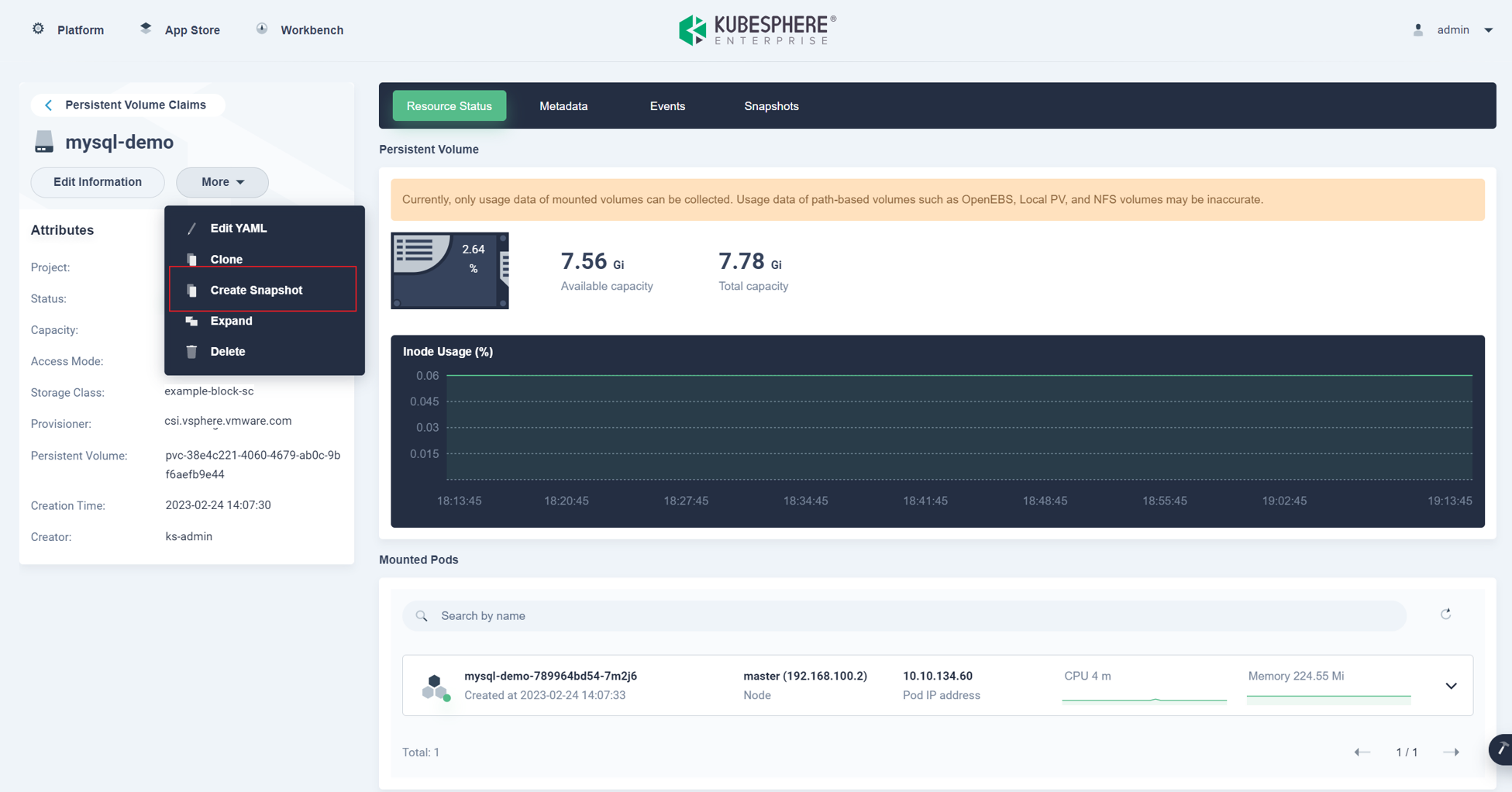
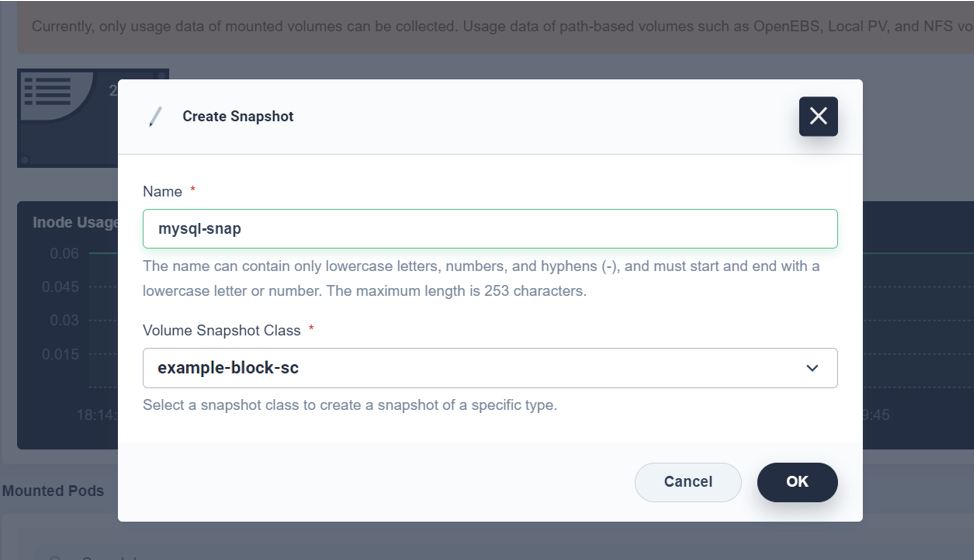


Insert data to the MySQL database:

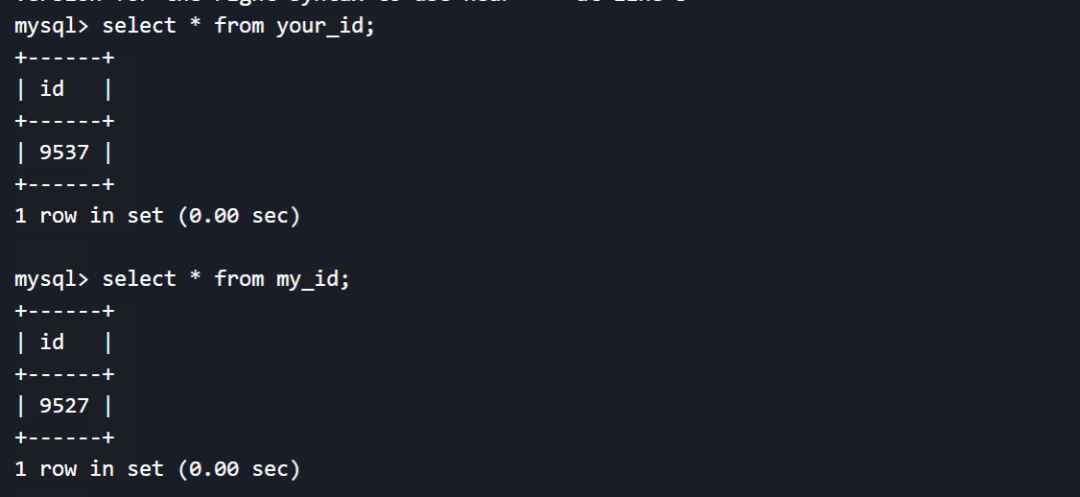
Delete the PVC that is bound. Then, verify that the PVC cannot be found in the MySQL database.


Use the snapshot created for the PVC, and connect to the MySQL database to query data:

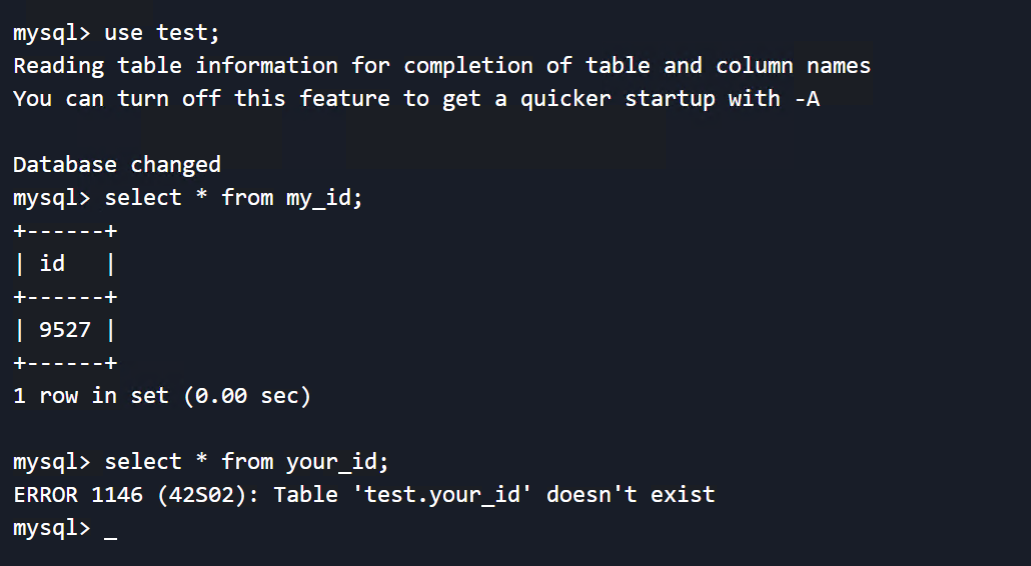
Monitoring
The vSphere CSI driver provides Prometheus-based monitoring metrics, including metrics for CNS components and storage. In the KubeSphere web console, you can use the monitoring exporter to create ServiceMontior:
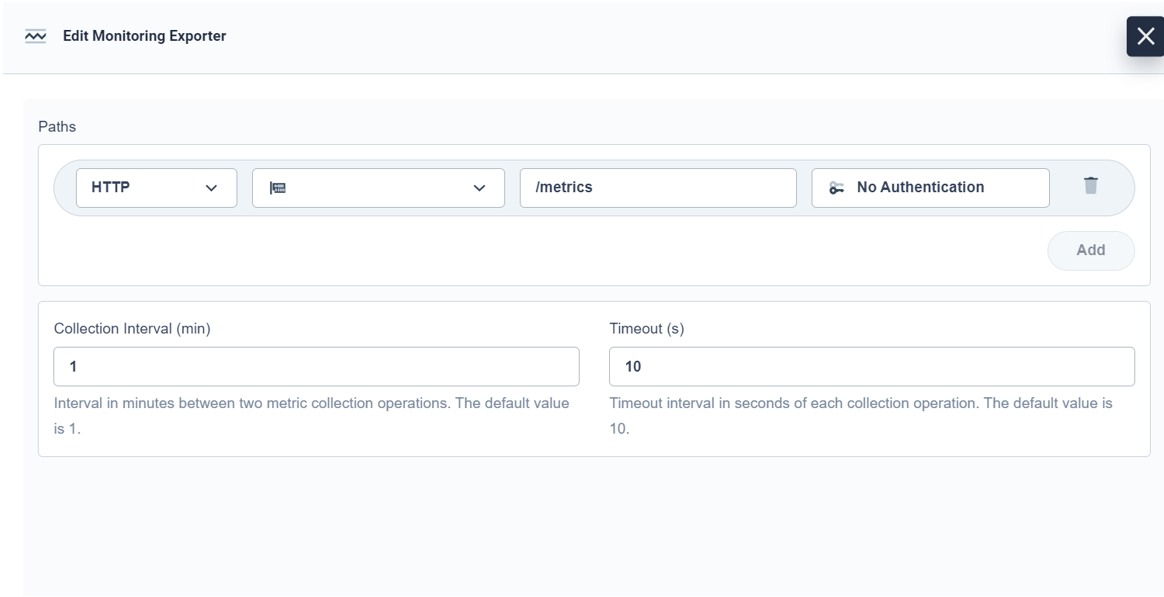
vSphere provides Grafana monitoring templates available for use:
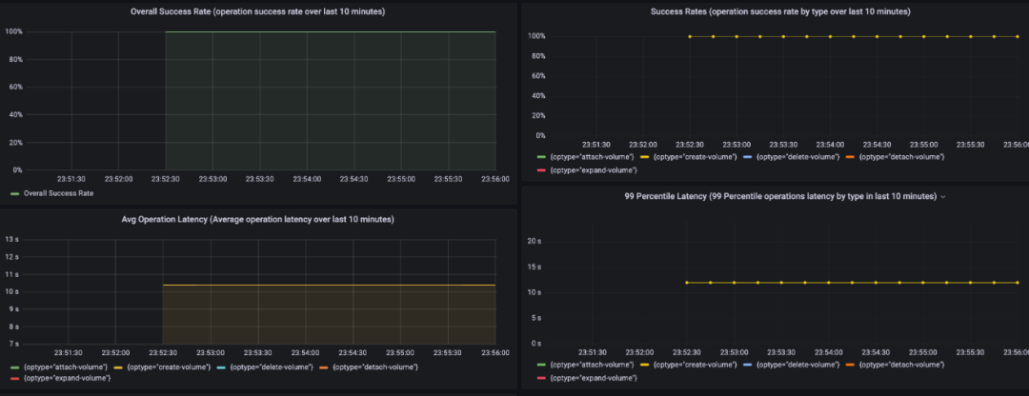
In the KubeSphere web console, you can configure custom dashboards based on monitoring metrics, such as the number of times that block storage is successfully created.

Administrators can also view CNS monitoring data in vCenter.
Note: This section introduces the Cloud Native Storage (CNS) features in vSAN for standard or ‘vanilla’ Kubernetes clusters. See the link below for more information on CNS for vSphere:
https://blogs.vmware.com/virtualblocks/2019/08/14/introducing-cloud-native-storage-for-vsphere/
Integrate KubeSphere with Antrea
Deploy Antrea and antctl
kubectl apply -f https://raw.githubusercontent.com/antrea-io/antrea/main/build/yamls/antrea.yml
kubectl get pod -n kube-system | grep antrea
antrea-agent-4gbn8 2/2 Running 36d
antrea-agent-n8v2k 2/2 Running 36d
antrea-agent-wznw6 2/2 Running 36d
antrea-controller-879cc648-jgp5x 1/1 Running 40d
Use KubeKey to deploy a Kubernetes cluster and Antrea at ease
Create a cluster configuration file:
./kk create config -f config.yaml
vi config.yaml
apiVersion: kubekey.kubesphere.io/v1alpha2
kind: Cluster
metadata:
name: example
spec:
hosts:
- {name: node1, address: 172.16.0.2, internalAddress: 172.16.0.2, privateKeyPath: "~/.ssh/id_rsa"}
- {name: node2, address: 172.16.0.3, internalAddress: 172.16.0.3, privateKeyPath: "~/.ssh/id_rsa"}
- {name: node3, address: 172.16.0.4, internalAddress: 172.16.0.4, privateKeyPath: "~/.ssh/id_rsa"}
...
network:
plugin: none
kubePodsCIDR: 10.16.0.0/16
kubeServiceCIDR: 10.96.0.0/16
...
addons:
- name: antrea
namespace: kube-system
sources:
chart:
name: antrea
repo: https://charts.antrea.io
Run the kk create cluster -f config.yaml command to deploy the Kubernetes cluster and Antrea.
KubeKey supports using yaml files or Helm charts to install Antrea as an add-on. Support for network plugin is in assessment and might be implemented in future versions.
You can view the CRD resources related to Antrea in the KubeSphere web console.
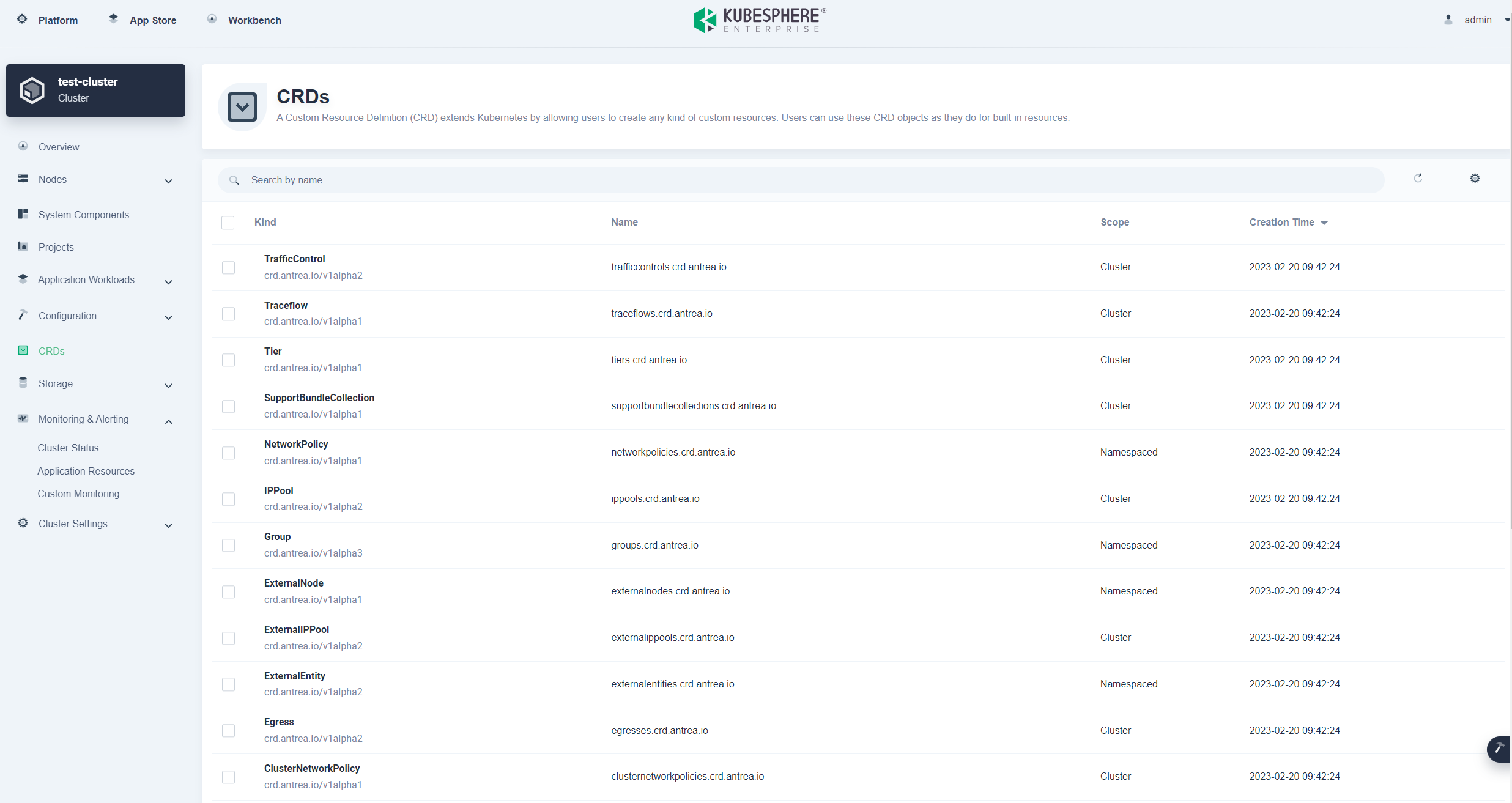
Three projects for Antrea, Flow Aggregator, and Theia will be rolled out on KubeSphere App Store. You can directly install these applications from the App Store in this way.

Traffic walk
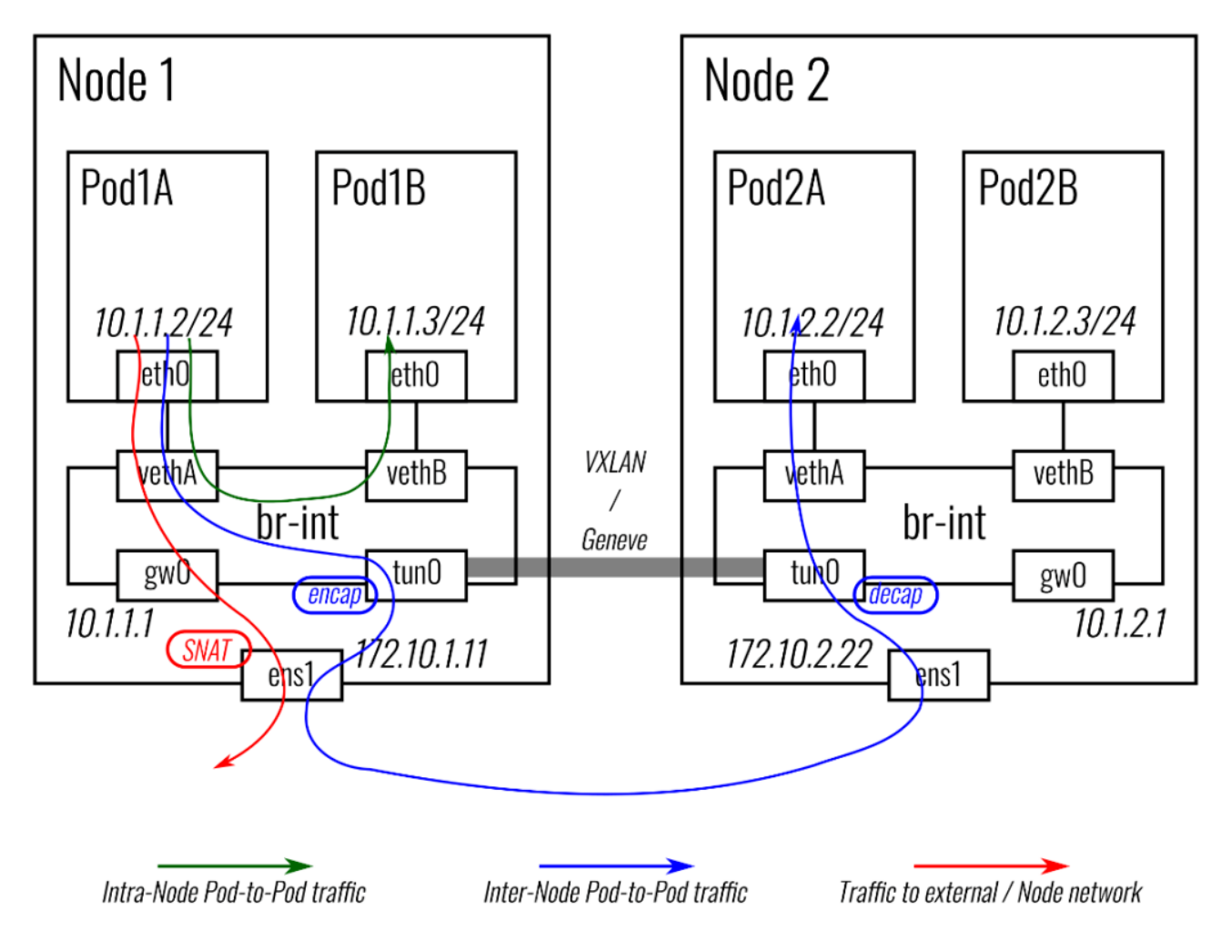
The image is cited from the Antrea official website, which can help you familiarize yourself with Antrea's communication mode.
- Intra-node traffic
Packets between two local pods will be forwarded by the OVS bridge directly.
- Inter-node traffic
Packets to a pod on another node will be first forwarded to the antrea-tun0 port, encapsulated, and sent to the destination node through the tunnel; then they will be decapsulated, injected through the antrea-tun0 port to the OVS bridge, and finally forwarded to the destination pod.
- Pod to external traffic
Packets sent to an external IP or the Nodes' network will be forwarded to the antrea-gw0 port (as it is the gateway of the local Pod subnet), and will be routed (based on routes configured on the Node) to the appropriate network interface of the Node (for example, a physical network interface for a bare metal node) and sent out to the Node network from there. Antrea Agent creates an iptables (MASQUERADE) rule to perform SNAT on the packets from Pods, so their source IP will be rewritten to the Node’s IP before going out.
Security
Antrea ensures security from the following aspects:
- Control plane security
All API communication between Antrea control plane components is encrypted with TLS. You can generate the required certificate manually, or manage certificates by using cert-manager.
- Traffic encryption
Antrea supports encrypting tunnel traffic across nodes with IPsec ESP or WireGuard, to meet audit and security compliance for enterprises.
- Network policies
Network policies are native Kubernetes resources that include a whitelist of allowed egress rules. However, Kubernetes-native network policies do not support node-level control, events and logging, display of traffic rejection, cluster-level control, fine-grained action rules, and policy priorities.
Compared with Kubernetes-native network policies, Antrea abstracts a lot of network details and offers CRDs such as Tier, ClusterGroup, Group, ClusterNetworkPolicy, and NetworkPolicy. It defines policy priorities, groups resources by cluster or namespace, and supports cluster network policies. In contrast, Kubernetes-native network policies are similar to firewall rules for O&M personnel.
Antrea provides Tiers with specific priorities. You can attach a network policy to any Tier.
Emergency > SecurityOps > NetworkOps > Platform > Application > K8s NetworkPolicy > Baseline
In a ClusterGroup resource, you can specify labels, CIDR blocks, services, and member groups as needed.
Sample code:
apiVersion: crd.antrea.io/v1alpha3
kind: ClusterGroup
metadata:
name: demo-cluster-group
spec:
podSelector:
matchLabels:
role: db
namespaceSelector:
matchLabels:
env: prod
ipBlocks:
- cidr: 10.0.10.0/24
serviceReference:
name: test-service
namespace: default
childGroups: [test-cg-sel, test-cg-ip-blocks, test-cg-svc-ref]
After the resource is defined, you can configure a network policy. In the following example, the policy priority is set to 5, and the policy applies to the resource group named test-db. Each ClusterNetworkPolicy might consist of zero or more ordered set of ingress or egress rules. Each rule, depending on the action field of the value, allows, drops, rejects, or passes traffic. Each policy can work together with multiple selectors and resources, such as ports, ipBlock, services, FQDN, ICMP, IGMP, and HTTP. You can enable logging for resources. Logs are stored in /var/log/antrea/networkpolicy/np.log, and you can use tools such as Filebeat to collect and analyze logs. The design of NetworkPolicy is similar to that of ClusterNetworkPolicy. This way, you can implement secure network policies at Layer 3 to Layer 7.
Sample code:
apiVersion: crd.antrea.io/v1alpha1
kind: ClusterNetworkPolicy
metadata:
name: acnp-demo
spec:
priority: 5
tier: securityops
appliedTo:
- group: "test-db"
ingress:
- action: Allow #[“Allow”, “Drop”, “Reject”, “Pass”]
from:
- podSelector:#[“podSelector”, “namespaceSelector”, “nodeSelector”]
matchLabels:
role: frontend
ports:
- protocol: TCP
port: 8080
endPort: 9000
name: AllowFromFrontend
enableLogging: false
egress:
- action: Drop
to:
- ipBlock:
cidr: 10.0.10.0/24
ports:
- protocol: TCP
port: 5978
# toServices:
# - name: svcName
# namespace: svcNamespace
# protocols:
# - icmp:
# icmpType: 8
# icmpCode: 0
# l7Protocols:
# - http:
# path: "/api/v2/*"
# host: "foo.bar.com"
# method: "GET"
name: DropToThirdParty
enableLogging: true
IPAM
Antrea provides two types of IPAM capabilities, that is, NodeIPAM and AntreaIPAM.
NodeIPAM is a Kubernetes component, which manages IP address pool allocation per each node, when the node initializes. Antrea NodeIPAM controller can be executed in scenarios where the NodeIPAMController is disabled in kube-controller-manager.
When a Pod’s IP is allocated from an IP Pool, the traffic from the Pod to Pods on another Node or from the Pod to external networks will be sent to the underlay network through the Node’s transport network interface and will be forwarded or routed by the underlay network.
In real life practice, if you use underlay networks, use AntreaIPAM to allocate IP addresses and connect to physical networks. If you use overlay networks, use Multus for the second NIC and AntreaIPAM for VLAN connections.
{
"cniVersion": "0.3.0",
"name": "ipv4-net-1",
"type": "macvlan",
"master": "eth0",
"mode": "bridge",
"ipam": {
"type": "antrea",
"ippools": [ "ipv4-pool-1" ]
}
}
kind: Pod
metadata:
annotations:
ipam.antrea.io/ippools: 'pod-ip-pool1'
Egress
When pods access critical applications such as databases outside the cluster, security audits are required. In this scenario, you can adopt egress gateways. Egress is a CRD API that manages external access from the Pods in a cluster. It supports specifying which egress (SNAT) IP the traffic from the selected Pods to the external network should use.
Sample code:
apiVersion: crd.antrea.io/v1alpha2
kind: Egress
metadata:
name: egress-prod-web
spec:
appliedTo:
namespaceSelector:
matchLabels:
env: prod
podSelector:
matchLabels:
role: web
egressIP: 10.10.0.8
externalIPPool: prod-external-ip-pool
You can use egressIP and externalIPPool to specify Egress resources. The specified IP address must be accessible over physical networks. High availability is provided automatically when the egressIP is allocated from an externalIPPool; for example, when the externalIPPool is specified. If the Node hosting the egressIP fails, another Node will be selected (from among the remaining Nodes selected by the nodeSelector of the externalIPPool) as the new egress Node of this Egress. It will take over the IP and send layer 2 advertisement (for example, Gratuitous ARP for IPv4) to notify the other hosts and routers on the network that the MAC address associated with the IP has changed.
NodePortLocal
In Kubernetes, you can use NodePort or LoadBalancer to expose services. LoadBalancers such as F5, Server Load Balancer (SLB), and OpenELB can help you create a service like ClusterIP and open a port on each node.NodePorts expose services on static ports that range from 30000 to 32767. However, the design of kube-proxy can cause issues in various scenarios, such as traffic distribution, session persistence, health check on external loads, and numerous ports occupied.
NodePortLocal creates mappings between NodeIP:Port and PodIP:Port, so each pod can access each other by using NodeIP and NodePort. This feature is suitable for the traditional business that transforms to cloud native, for example, clusters where microservices reside and interconnection between registries and clusters.
Add service annotations:
apiVersion: v1
kind: Service
metadata:
name: nginx
annotations:
nodeportlocal.antrea.io/enabled: "true"
spec:
ports:
- name: web
port: 80
protocol: TCP
targetPort: 80
selector:
app: nginx
View pod annotations:
[root@ks1-master ~]# kubectl get pods nginx-85b98978db-fwbmw -oyaml
apiVersion: v1
kind: Pod
metadata:
annotations:
nodeportlocal.antrea.io: '[{"podPort":80,"nodeIP":"192.168.100.5","nodePort":61001,"protocol":"tcp","protocols":["tcp"]}]'
creationTimestamp: "2022-11-28T08:53:35Z"
generateName: nginx-85b98978db-
labels:
app: nginx
pod-template-hash: 85b98978db
name: nginx-85b98978db-fwbmw
namespace: default
Access the service in the NodeIP:NodePort format:

Query NAT rules:
conntrack -L -j |grep 10.10.1.24
tcp 6 431970 ESTABLISHED src=192.168.255.254 dst=192.168.100.5 sport=7149 dport=61001 packets=2 bytes=92 src=10.10.1.24 dst=192.168.255.254 sport=80 dport=7149 packets=1 bytes=52 [ASSURED] mark=0 delta-time=29 use=1
TraceFlow
Antrea supports using Traceflow for network diagnosis. You must be familiar with this feature if NSX is not new to you. Creating a new Traceflow CRD triggers the Traceflow module to inject packet into OVS, provide various observation points along the packet’s path, and populate these observations into the status field of the Traceflow CRD.
You can use antctl or octant to visualize Traceflow results:
[root@ks1-master ~]# antctl tf -S nginx-85b98978db-ckgtz -D nginx-85b98978db-fwbmw
name: nginx-85b98978db-ckgtz-to-nginx-85b98978db-fwbmw-rsc7pnr6
phase: Succeeded
source: default/nginx-85b98978db-ckgtz
destination: default/nginx-85b98978db-fwbmw
results:
- node: ks1-worker2
timestamp: 1669629401
observations:
- component: Forwarding
action: Received
- component: Forwarding
componentInfo: Output
action: Delivered
- node: ks1-worker1
timestamp: 1669629401
observations:
- component: SpoofGuard
action: Forwarded
- component: Forwarding
componentInfo: Output
action: Forwarded
tunnelDstIP: 192.168.100.5
Network observability
To visualize network traffic, Antrea offers Flow Aggregator and Theia. Antrea monitors the flows in Linux conntrack module. These flows are converted to flow records, and then flow records are post-processed before they are sent to the configured external flow collector. In Antrea, the basic building block for the Network Flow Visibility is the Flow Exporter. Connections from the connection store are exported to the Flow Aggregator Service using the IPFIX protocol and displayed on Grafana through Theia.
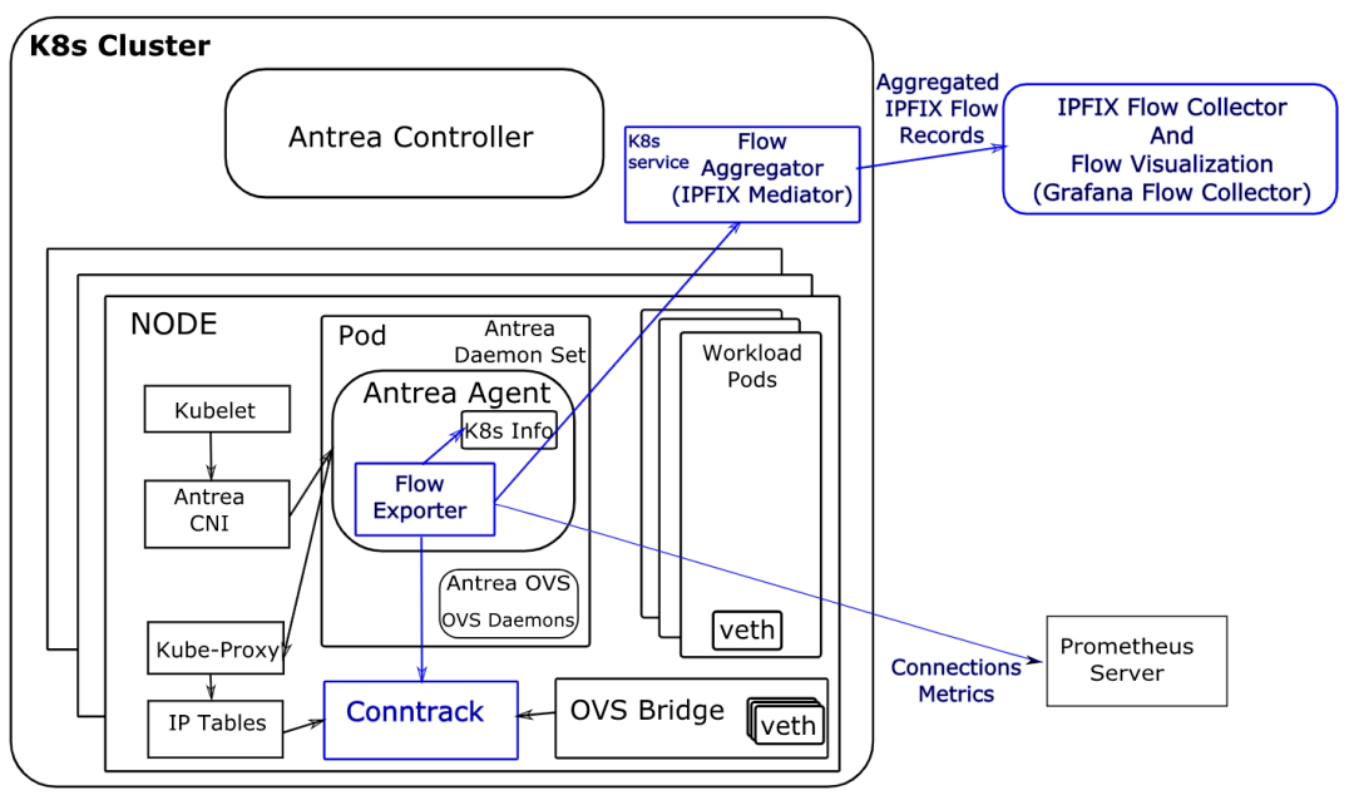
Use KubeSphere App Store to deploy Flow Aggregator and Theia:
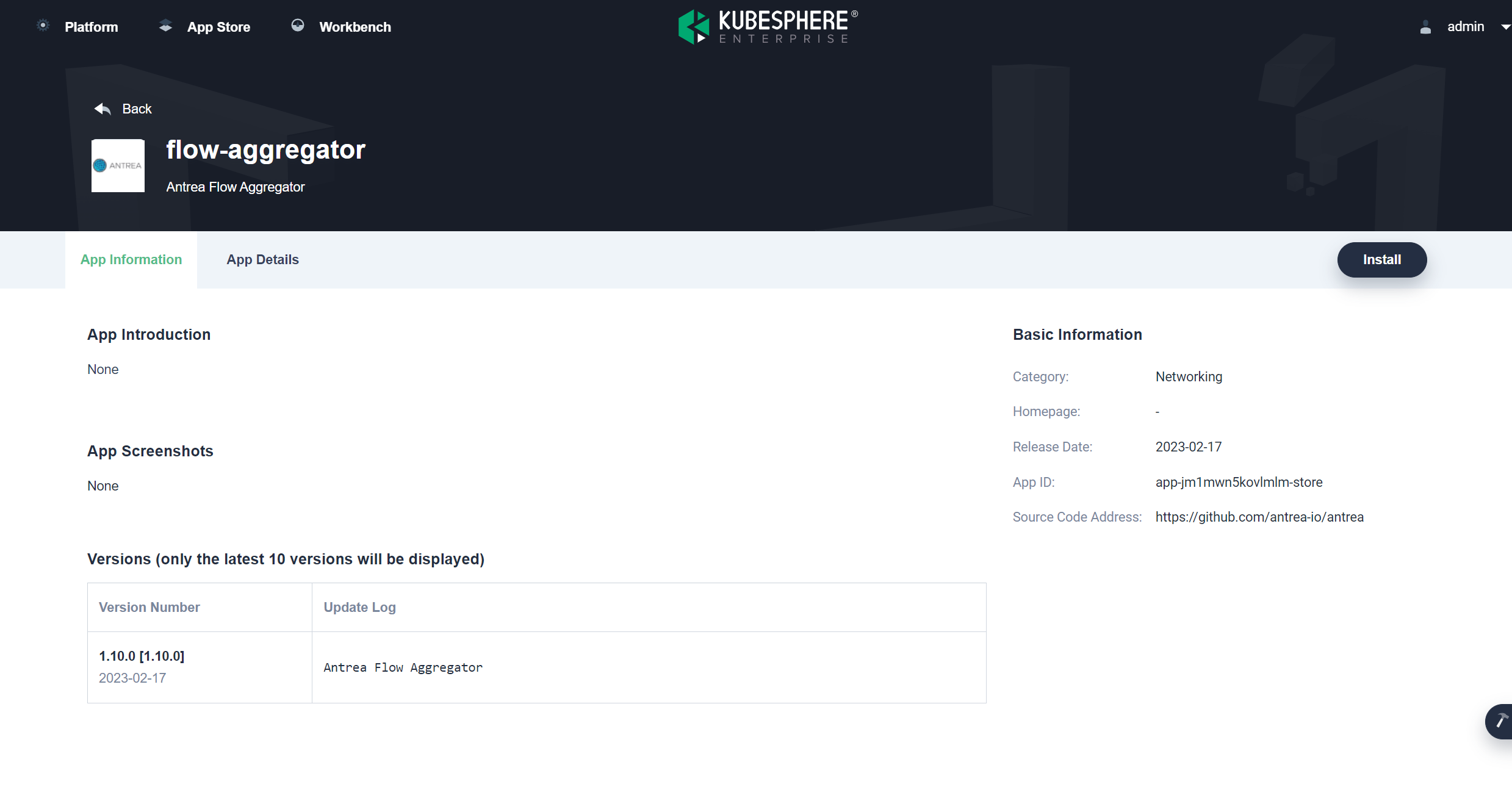
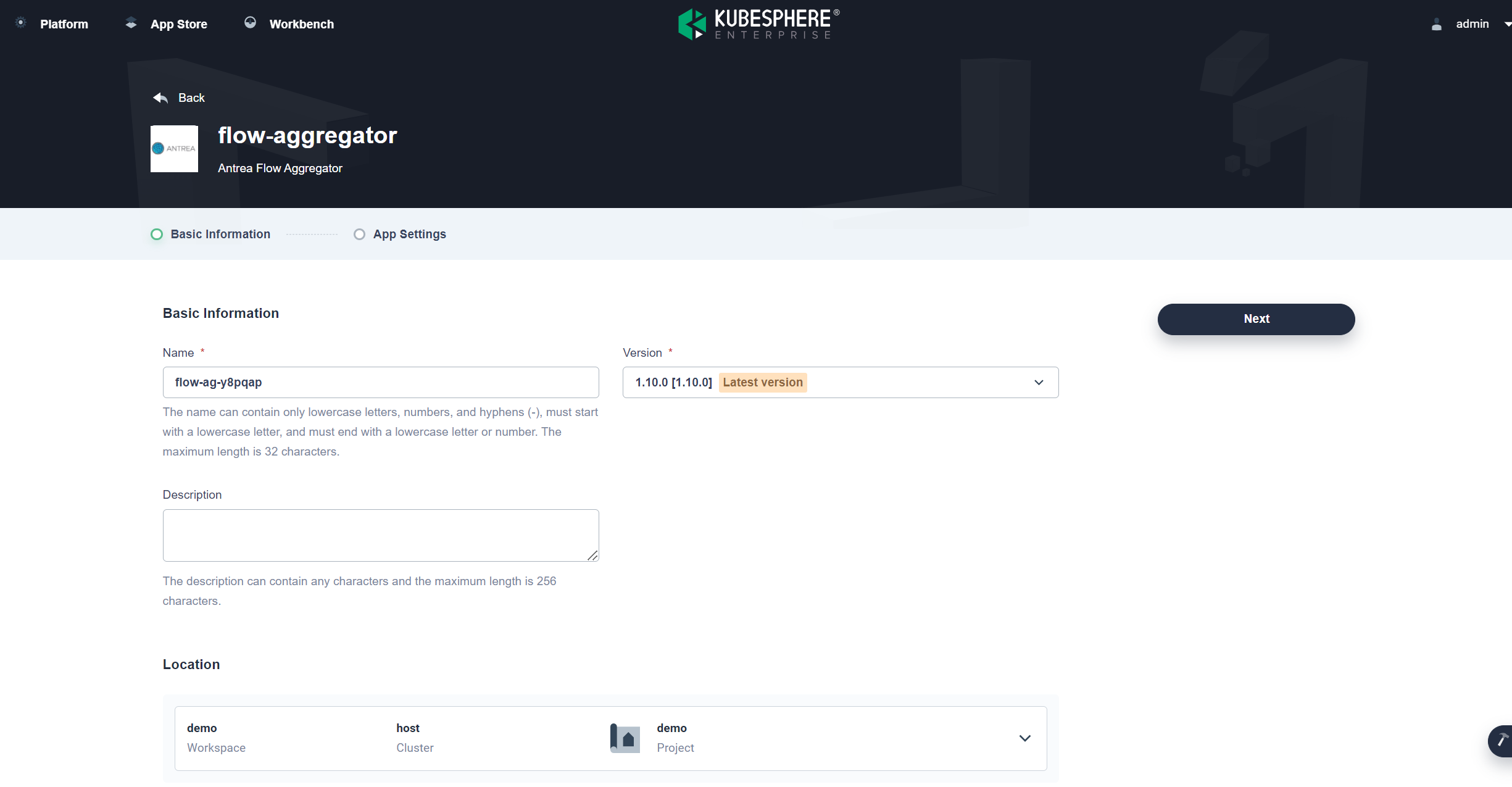
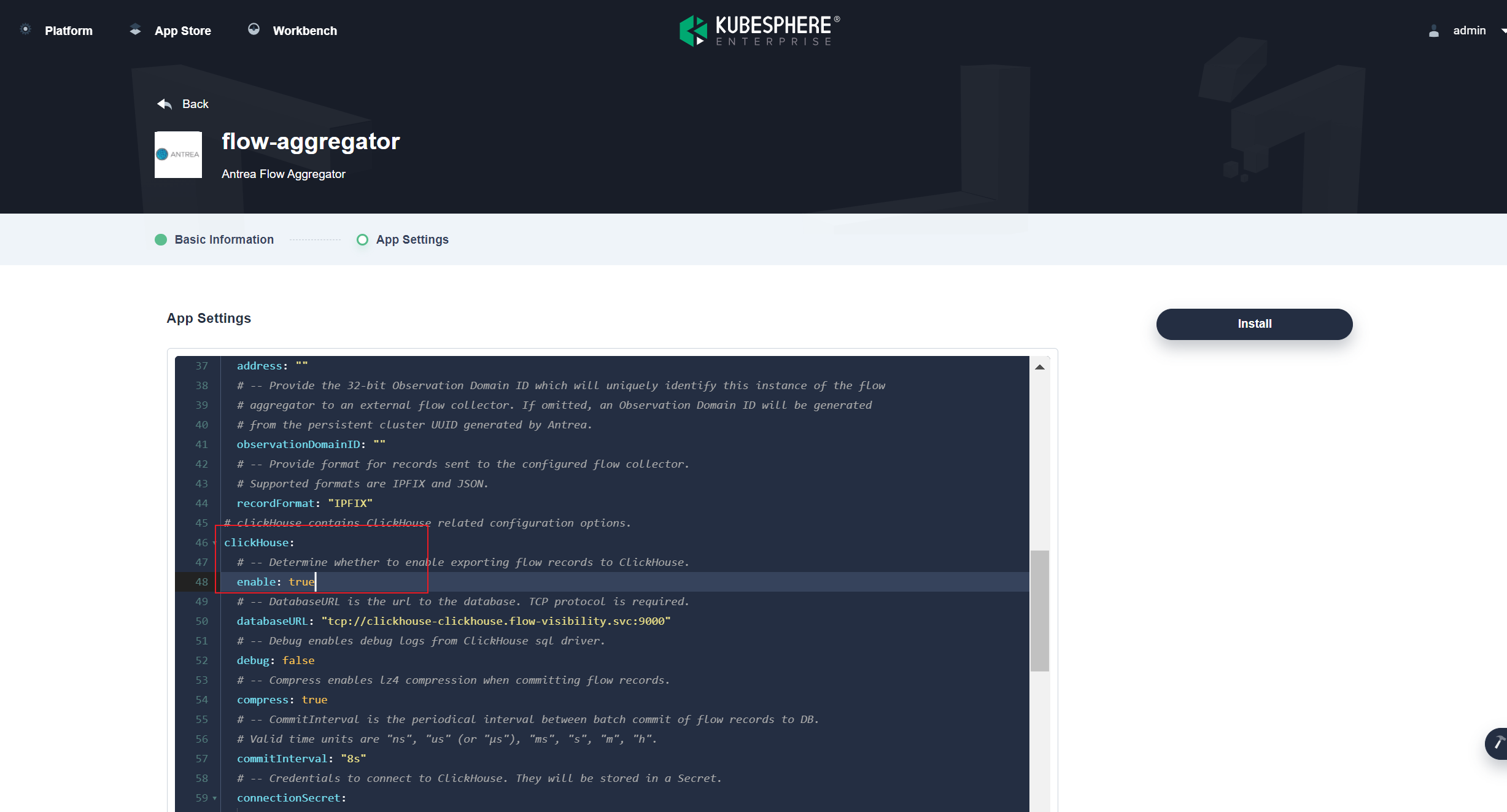
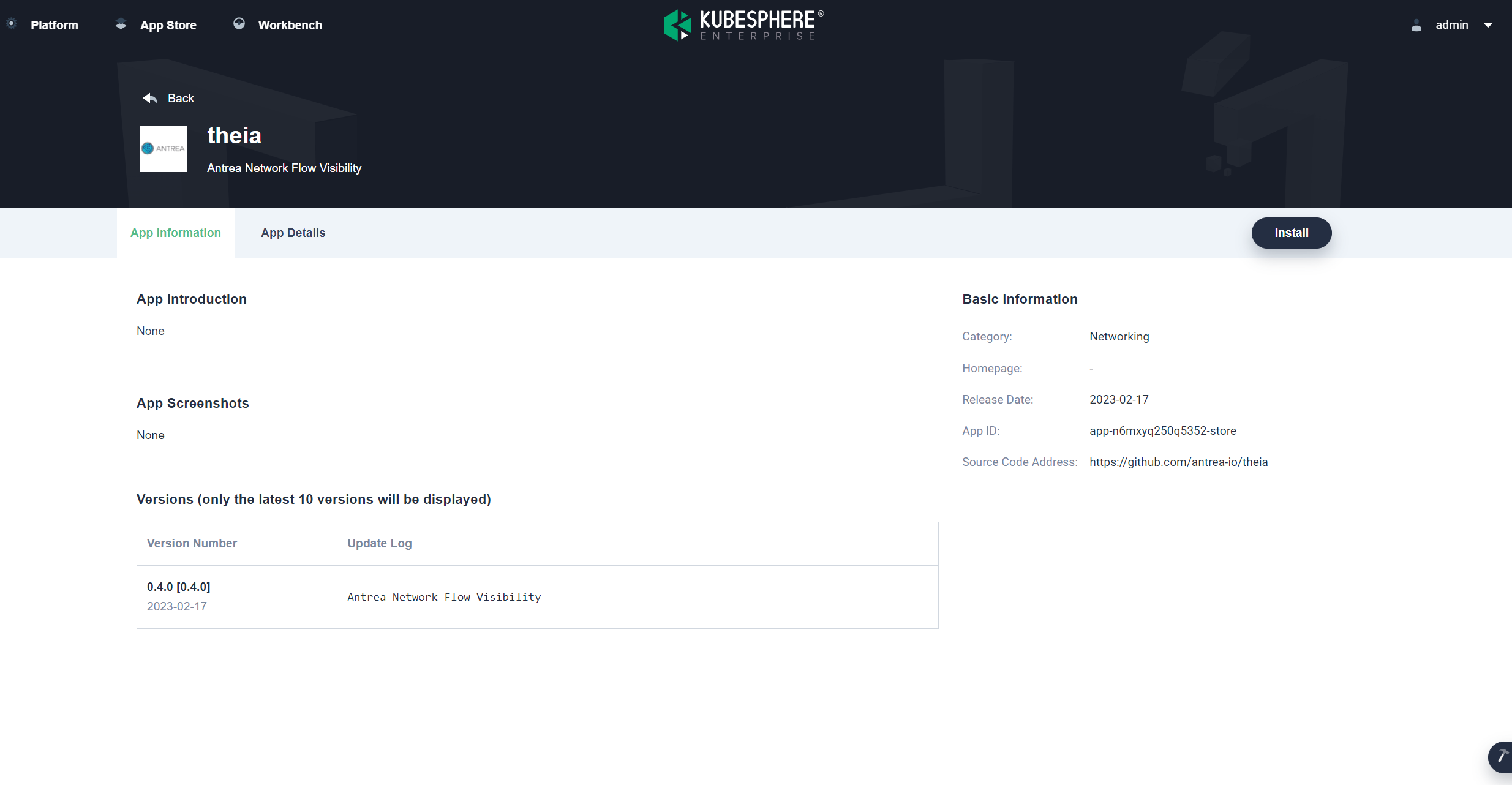
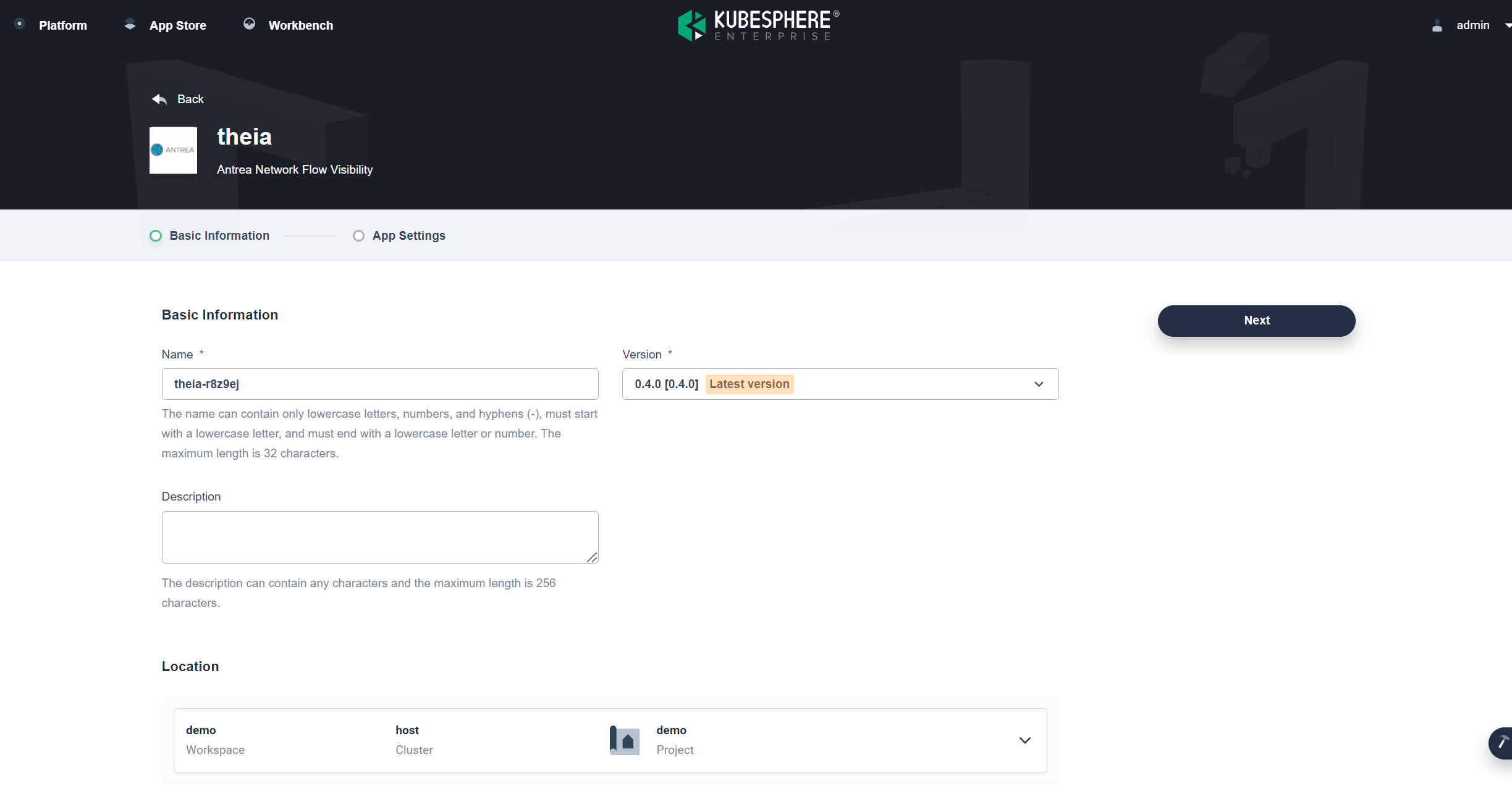
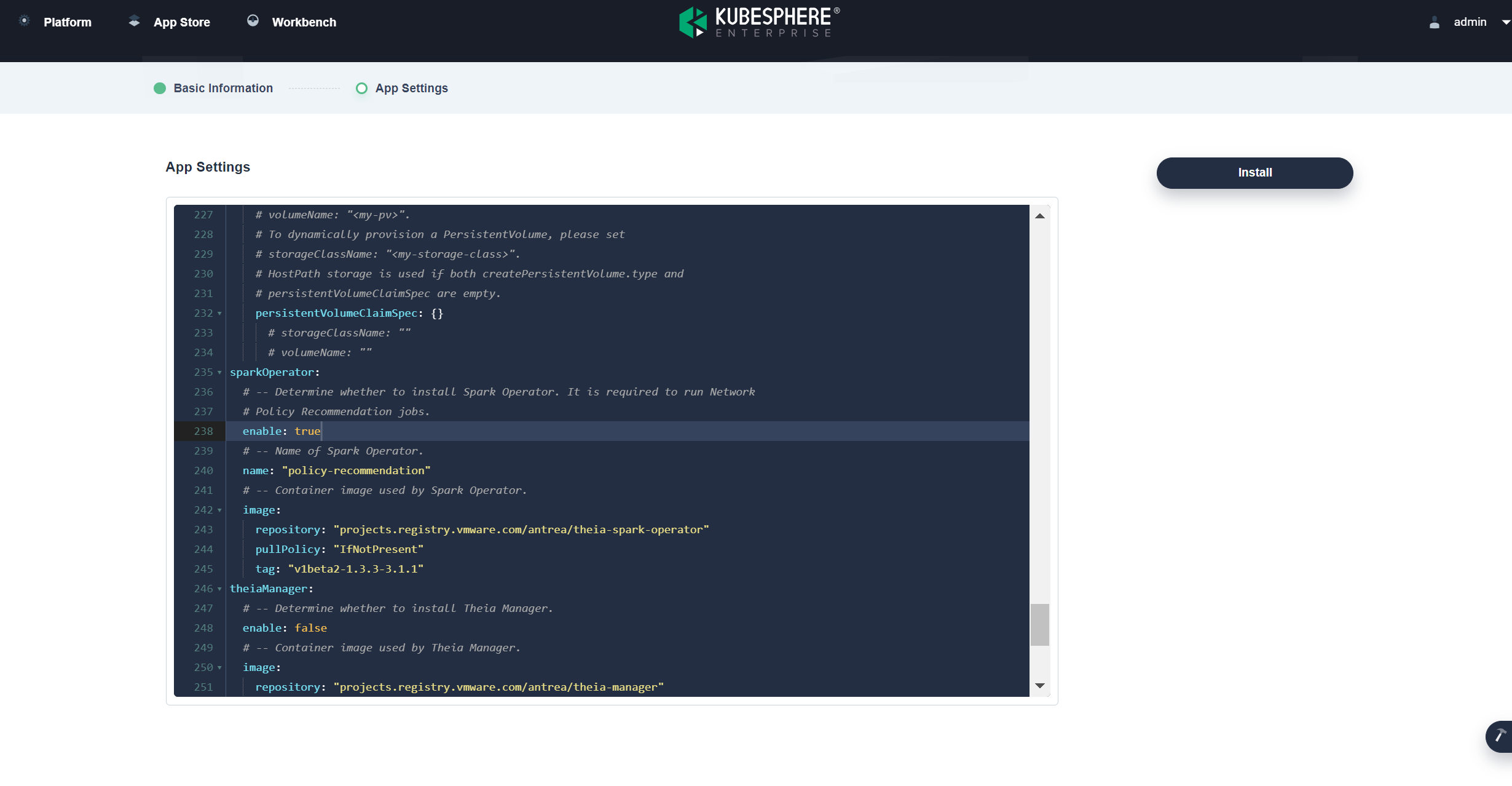
View statistical data on Grafana:

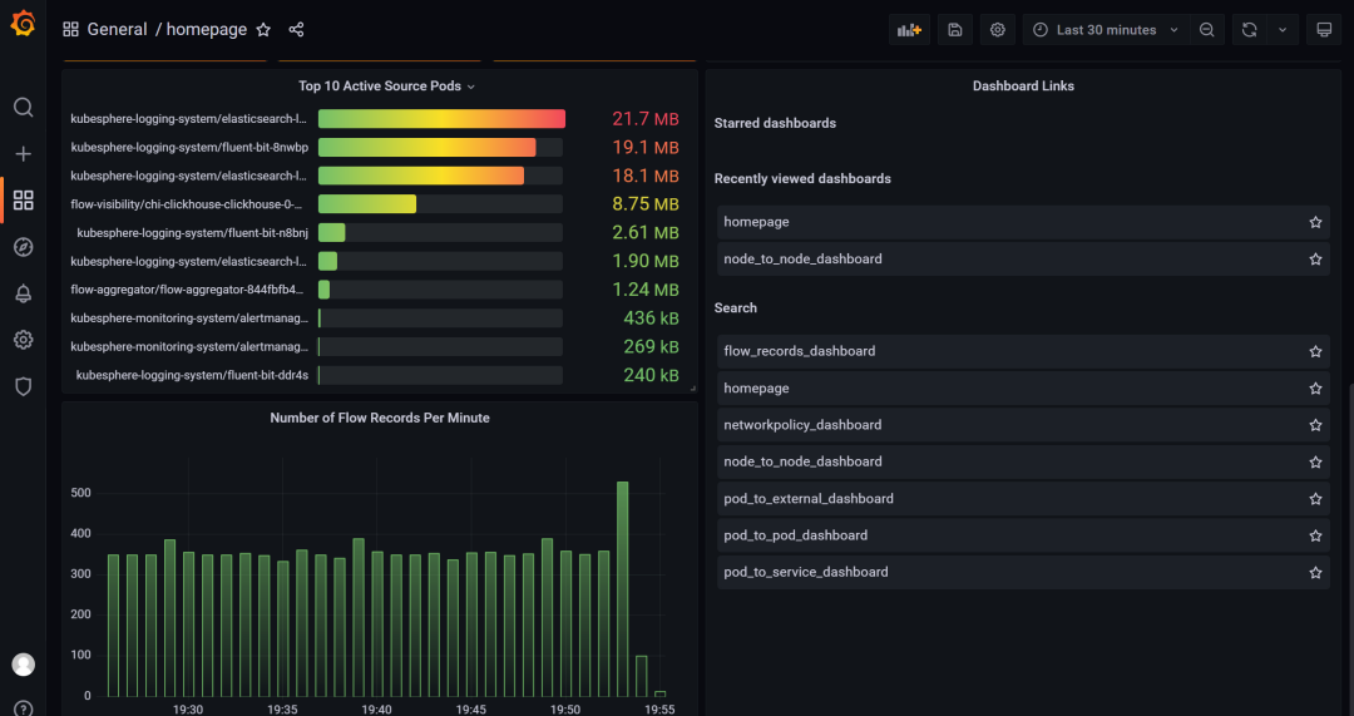
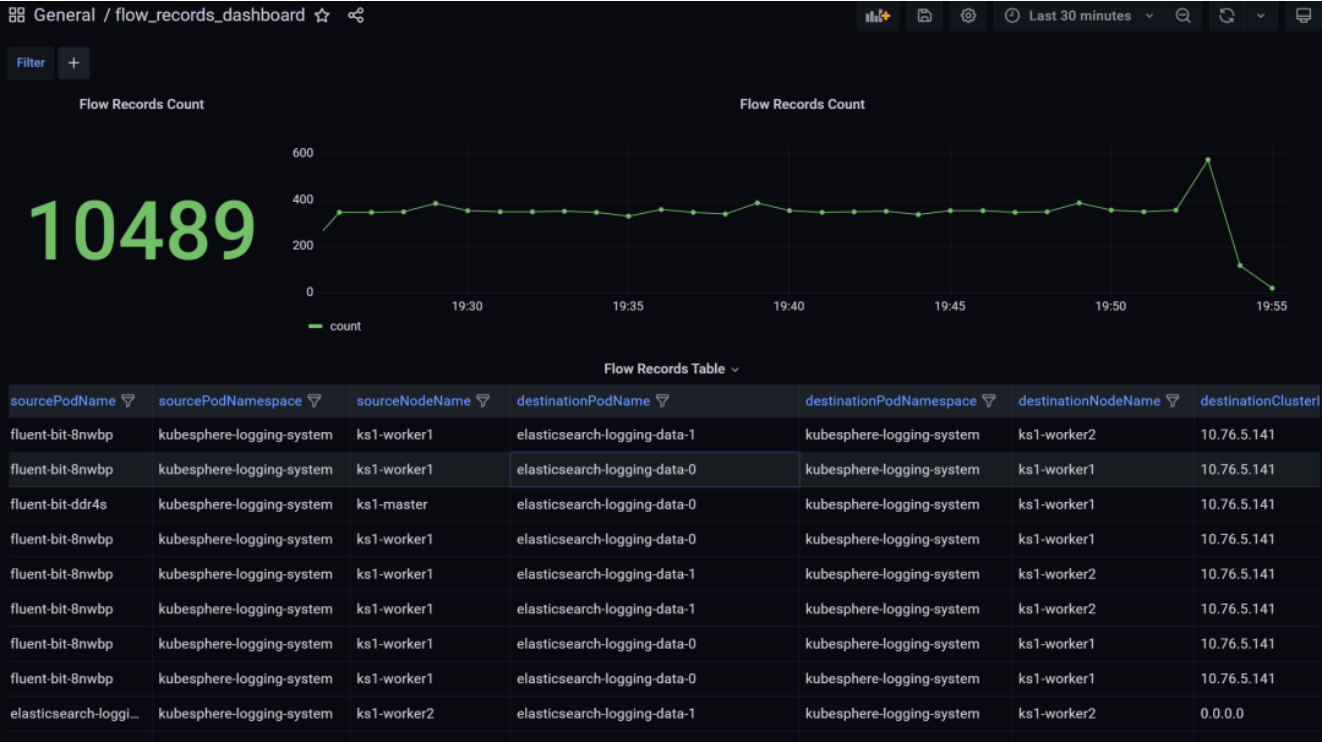
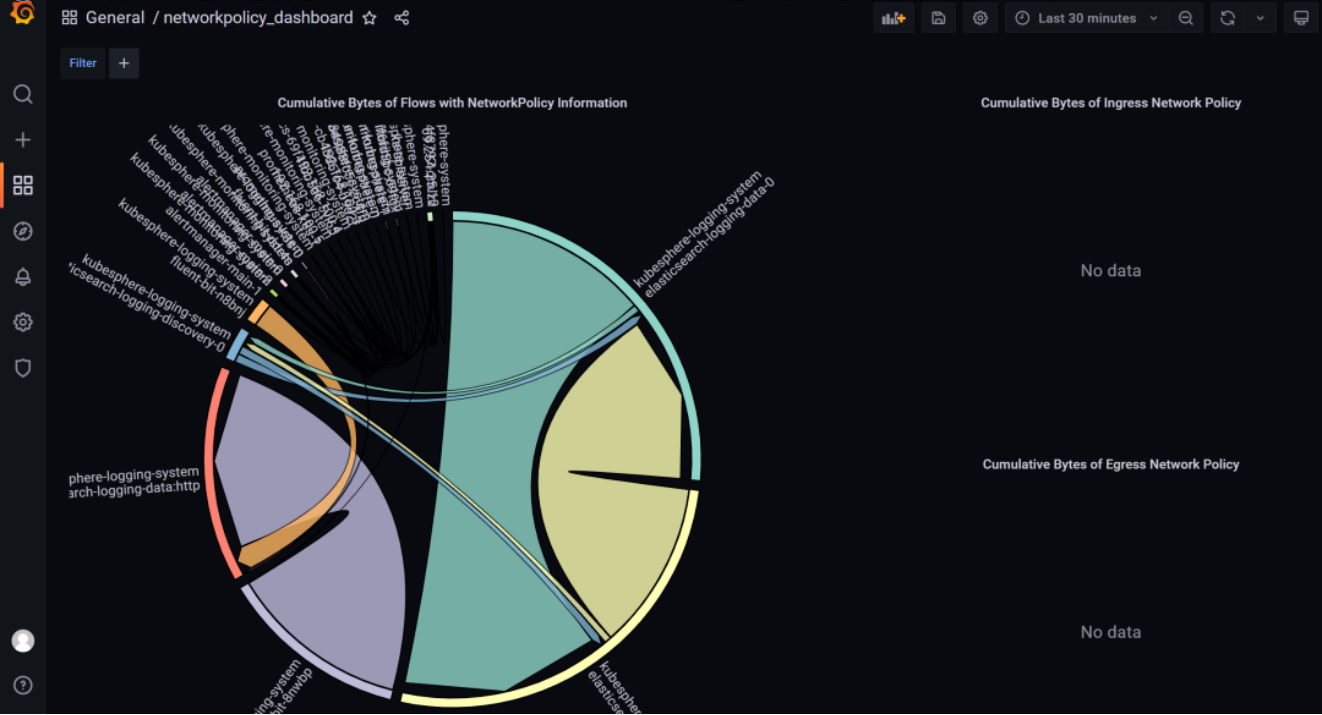
Theia also provides suggestions on network policies and security hardening for platform components and system architectures.
Sample code:
theia policy-recommendation run
theia policy-recommendation list
CreationTime CompletionTime ID Status
2022-10-08 06:35:04 2022-10-08 06:38:00 60a79979-19ed-40a7-bc11-2b389a8a43bb COMPLETED
theia policy-recommendation retrieve --id 60a79979-19ed-40a7-bc11-2b389a8a43bb
apiVersion: crd.antrea.io/v1alpha1
kind: ClusterNetworkPolicy
metadata:
name: recommend-allow-acnp-kube-system-f2g5l
spec:
appliedTo:
- namespaceSelector:
matchLabels:
kubernetes.io/metadata.name: kube-system
egress:
- action: Allow
to:
- podSelector: {}
ingress:
- action: Allow
from:
- podSelector: {}
priority: 5
tier: Platform
---
apiVersion: crd.antrea.io/v1alpha1
kind: ClusterNetworkPolicy
metadata:
name: recommend-allow-acnp-flow-aggregator-uny5c
spec:
appliedTo:
- namespaceSelector:
matchLabels:
kubernetes.io/metadata.name: flow-aggregator
egress:
- action: Allow
to:
- podSelector: {}
ingress:
- action: Allow
from:
- podSelector: {}
priority: 5
tier: Platform
---
apiVersion: crd.antrea.io/v1alpha1
kind: ClusterNetworkPolicy
metadata:
name: recommend-allow-acnp-flow-visibility-ecj61
spec:
appliedTo:
- namespaceSelector:
matchLabels:
kubernetes.io/metadata.name: flow-visibility
egress:
- action: Allow
to:
- podSelector: {}
ingress:
- action: Allow
from:
- podSelector: {}
priority: 5
tier: Platform
Multi-cluster networking
Antrea Multi-cluster implements connectivity between pods or services. A Multi-cluster ClusterSet is comprised of a single leader cluster and at least two member clusters. Then, pods can access each other via pod IP addresses, and services can access each other via import or export.
Assume that the following two clusters exist:
Cluster A: Apiserver 192.168.100.3:6443, podCIDR 10.10.0.0/16
Cluster B: Apiserver 192.168.100.6, podCIDR 10.20.0.0/16
Enable the multi-cluster feature:
kubectl edit cm -n kube-system
# Enable Antrea Multi-cluster Gateway to support cross-cluster traffic.
# This feature is supported only with encap mode.
Multicluster: true
Create a namespace named antrea-multicluster and use antctl to deploy ClusterSet:
kubectl create ns antrea-multicluster
antctl mc deploy leadercluster -n antrea-multicluster --antrea-version v1.10.0
antctl mc deploy membercluster -n kube-system --antrea-version v1.10.0
Create a ClusterSet in cluster A, which works as the leader cluster and has two member clusters.
antctl mc init --clusterset test-clusterset --clusterid test-cluster-leader -n antrea-multicluster --create-token -j join-config.yml
antctl mc join --clusterid test-cluster-leader -n kube-system --config-file join-config.yml
Query ClusterClaim and ClusterSet.
kubectl get clustersets.multicluster.crd.antrea.io -A
NAMESPACE NAME LEADER CLUSTER NAMESPACE TOTAL CLUSTERS READY CLUSTERS AGE
antrea-multicluster test-clusterset antrea-multicluster 1 1 4m12s
kube-system test-clusterset antrea-multicluster 1 1 4m4s
kubectl get clusterclaims.multicluster.crd.antrea.io -A
NAMESPACE NAME VALUE AGE
antrea-multicluster clusterset.k8s.io test-clusterset 4m32s
antrea-multicluster id.k8s.io test-cluster-leader 4m32s
kube-system clusterset.k8s.io test-clusterset 4m24s
kube-system id.k8s.io test-cluster-leader 4m24s
Specify the Gateway Node for cluster A, which is responsible for routing all cross-clusters traffic from the local cluster to other member clusters through tunnels.
kubectl annotate node ks1-master multicluster.antrea.io/gateway=true
Deploy member cluster B.
antctl mc deploy membercluster -k ~/.kube/config1 -n kube-system --antrea-version v1.10.0
Add cluster B to ClusterSet.
antctl mc deploy membercluster -k ~/.kube/config1 -n kube-system --antrea-version v1.9.0
Configure the Gateway Node for cluster B.
kubectl annotate node ks2 multicluster.antrea.io/gateway=true
Check the cluster status:
antctl mc get clusterset -A
CLUSTER-ID NAMESPACE CLUSTERSET-ID TYPE STATUS REASON
test-cluster-leader antrea-multicluster test-clusterset Ready True Connected
test-cluster-leader kube-system test-clusterset IsLeader True <NONE>
test-cluster-leader kube-system test-clusterset Ready True <NONE>
test-cluster-member antrea-multicluster test-clusterset Ready True Connected
Check cluster import:
kubectl get clusterinfoimport -n kube-system
NAME CLUSTER ID SERVICE CIDR AGE
test-cluster-member-clusterinfo test-cluster-member 10.86.0.0/16 28m
[root@ks2 ~]# kubectl get clusterinfoimport -n kube-system
NAME CLUSTER ID SERVICE CIDR AGE
test-cluster-leader-clusterinfo test-cluster-leader 10.76.0.0/16 32m
In antrea-mc-controller, specify podCIDR for which you want to enable connectivity:
kubectl edit configmap -n kube-system antrea-mc-controller-config
data:
controller_manager_config.yaml: |
apiVersion: multicluster.crd.antrea.io/v1alpha1
kind: MultiClusterConfig
health:
healthProbeBindAddress: :8080
metrics:
bindAddress: "0"
webhook:
port: 9443
leaderElection:
leaderElect: false
serviceCIDR: ""
podCIDRs:
- "10.10.0.0/16" #另一边为10.20.0.0/16
gatewayIPPrecedence: "private"
endpointIPType: "ClusterIP"
Test pod connectivity:
kubectl get pods -o wide
NAME READY STATUS RESTARTS AGE IP NODE NOMINATED NODE READINESS GATES
box2 1/1 Running 0 5m29s 10.10.2.2 ks1-worker1 <none> <none>
kubectl get pods -o wide
NAME READY STATUS RESTARTS AGE IP NODE NOMINATED NODE READINESS GATES
box1 1/1 Running 0 5m14s 10.20.0.4 ks2 <none> <none>
kubectl exec box1 ping 10.10.2.2
PING 10.10.2.2 (10.10.2.2): 56 data bytes
64 bytes from 10.10.2.2: seq=0 ttl=61 time=2.832 ms
Best Practices
This guide leverages the advantages of VMware cloud-native infrastructure and QingCloud KubeSphere container platform to provide users with a full-lifecycle cloud-native solution. For information about implementation and design, see the following best practices:
- Best practices for cloud native storage
- Best practices for cloud native networking:
- Best practices for deploying KubeSphere on VMware vSphere
- Best practices for container management
- DevOps Best Practices
Conclusion
Powered by QingCloud, KubeSphere can work together with VMware in a seamless manner to provide cloud native solutions, for example, integration with vSAN and CNS to provide storage solutions, and with Antrea to provide network solutions. VMware features high performance, high availability, stability, and scalability, and KubeSphere is scalable, open source, and native to clouds. This indicates that KubeSphere can help you run containers on VMware and minimize the learning costs and O&M pressure, so you can care about only the upper-layer applications and accelerate digital transformation of your business.
Reference
About the Author
Wei MA, Solution Architect at KubeSphere, QingCloud
Shuang YU, Product Director at QingCloud
The following reviewers also contributed to the paper contents:
- Fei LIU, Senior Solution Architect at VMware
- Jiali XU, Senior Manager at Cloud Infrastructure Solutions Department, VMware
- Qin XU, Senior Solution Architect at Cloud Infrastructure Solutions Department, VMware
- Ting YIN, Senior Solution Architect at Cloud Infrastructure Solutions Department, VMware
- Min ZHANG, Senior Network Security Product Expert at VMware
![]()

